MAGAZINE
The Magazine section offers some tips on how to make attainable New Year’s Resolutions and stick to them.
OPINIONS
Columnist Sophie Carter argues that the Democratic Party is poised to lose in the 2022 midterm elections. A11


The Magazine section offers some tips on how to make attainable New Year’s Resolutions and stick to them.
Columnist Sophie Carter argues that the Democratic Party is poised to lose in the 2022 midterm elections. A11

Francine Cardman, an associate professor at the Boston College School of Theology and Ministry (STM) and scholar of early Christianity and feminist theology, died on Jan. 21 at the age of 74.

“She’s left the impact that lots of great teachers and scholars do,” said Catherine Mooney, an associate professor of church history at the STM and long-term friend of Cardman. “She’s influenced scholarship in her field in terms of early Christian women and in terms of ethics and social justice, and also just personally, she’s impacted … people.”
Cardman began her career at BC in 2008 when the University’s Institute for Religious Education and Pastoral Ministry merged with the Weston Jesuit School of Theology—where she
had been teaching since 1979—to form what is now the STM.
Rev. Thomas Massaro, S.J., a professor of moral theology at Fordham University and former professor and dean at the STM, said Cardman was his professor when he was a student at Weston.
“She was an absolute expert on that large body of literature about the early centuries of the church, including doctrines, church history, organization of the church, [and] how we develop bishops and popes,” Massaro said.
In addition to learning from Cardman as a student, Massaro worked alongside her when he began teaching at Weston in 1997 and later at the STM.
Massaro said Cardman embodied everything that a colleague should be.
“[She was] easy to get along with, easy to talk to—that’s the core of collegiality—and I have to say, whip-smart, just super intelligent,” he said.
According to Massaro, Cardman brought a personal approach to her teaching.
“I’m sure that her students will remember her kind of personal approach to theology,” he said. “It wasn’t just abstract. … She would add a personal touch of anecdotes of colorful stories.”
Massaro said Cardman was also a great partner to the Jesuits.
“I just think that they all came away knowing her well, respecting her, and feeling respected by her, and that applies across the board,” Massaro said.
Cardman was an independent thinker, according to Mooney, with a deep understanding of the gospel and a strong sense of justice. In particular, Cardman had a deep knowledge of women’s roles in the early church— roles often made invisible, Mooney said.
Madison Baker laid her notebook down on the table. The front and back covers are enveloped by a homemade collage that she pieced together, and its pages are stuffed with notes about The Mad Ones, the musical that occupied the intimate Bonn Studio Theater from Jan. 27 to 30.
Opening the notebook at its centerfold, Baker, director of The Mad Ones and MCAS ’22, revealed that the lined pages are enshrouded by splashes of dark colors pierced by vibrant blues. Beside these harsh contrasts of light and dark, ordinary images of roads and highways appear sinister.
The notebook contains Baker’s creative inspiration for the musical and represents the process of getting the show from the page to the stage, a process which began in March 2021.
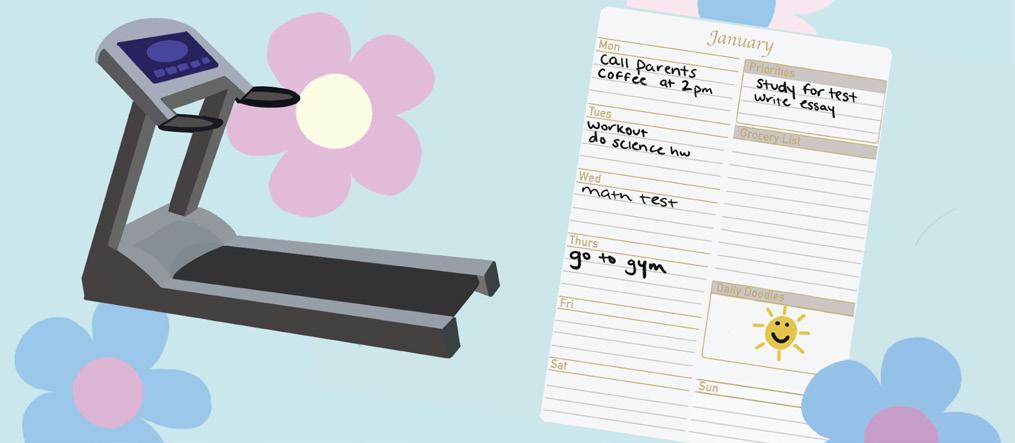
The Boston College theatre department reserves the position of director of its winter production for senior theatre majors, who apply for


the position and submit a proposal for the show they want to put on. Baker said that she has been anticipating the opportunity to direct a production since starting at BC.
“I was just so moved by the piece,” Baker said. “And I thought that it was such an important story to tell, but [it] still describes stress and anxiety and fear and vulnerability in a way that I had never seen before or articulated before.”
After the department accepted her application in the spring, Baker met with the show’s ensemble of student

The group brainstormed the show’s
themes,
As the effects of the COVID-19 pandemic continue to challenge the City of Newton, Newton municipal employees recently reached a 100 percent compliance rate with the city’s employee vaccination policy, according to Newton Mayor Ruthanne Fuller’s Jan. 21 newsletter.
Newton required all of the city’s employees to be fully vaccinated by Jan. 14 unless they have received an exemption, according to the city’s vaccination policy.
There are a total of 884 permanent municipal employees of Newton, according to Fuller’s newsletter. Of those, 790 employees are currently fully vaccinated, according to the newsletter, and 43 employees have pending requests for an exemption or are currently in the process of being vaccinated against COVID-19. The newsletter reported that 51 employees have already been approved for
exemptions.
Two non-union employees are no longer employed with the city after refusing to comply with this requirement, Fuller wrote. Four employees resigned or retired because of the vaccination policy, according to the newsletter.
“Once the pending employees come into full compliance, we expect that 95% of our City employees will be vaccinated, thus matching the extraordinarily high vaccination rate of our residents,” Fuller wrote.
Achieving the high compliance rate was done in coordination with many individuals and departments, particularly within unions.
“Over the past several months, our teams in Health and Human Services, Human Resources and the City Solicitor’s Department joined with all our City department staff to answer the questions of our employees and our City union leaders,” Fuller wrote.
Join the BAIC this Thursday at 5:30 p.m. in Gasson 100 for the Black History Month Opening Celebration to hear from keynote speaker Valerie Lewis-Mosley, co-founder of the AHANA acronym and BC ’79.
This Saturday at 9 a.m., BC will host its annual Women’s Summit, featuring keynote speakers Leah Thomas and Sarah Kay and multiple workshops to empower all attendees and share wisdom from different fields, including media, politics, and STEM.
Meet Farhad Sharifi, the refugee program advisor at the Research Program on Children and Adversity, this Wednesday at 4:30 p.m. in Devlin 101. The lecture will include an interview conducted by Maryanne Loughry and James F. Keenan, S.J., vice provost for global engagement.
Professors Kyrah Malika Daniels and Amey Victoria Adkins-Jones led a cultural dialogue about spirituality and social justice at the BRAVE Conference on Saturday morning.
“You never know where your path will take you, but your ethics and your community are what will sustain you,” said assistant professor of theology and African and African Diaspora Studies Adkins-Jones.
The virtual conference was hosted by the Thea Bowman AHANA and Intercultural Center.
The keynote speakers discussed the connections among relationships, spirituality, faith, and art, using these subjects as an opportunity for students to get together and reflect on their experiences.
“I’m always excited for us to think about the ways that we are resourced by our faith traditions, but also the ways that even our faith traditions call us and demand us as we continue to pursue and question what the limits to liberation have been, even from within,” Adkins-Jones said.
Daniels, an assistant professor of art history and African and African Diaspora Studies, tapped into her own heritage, sharing a story about the link between spirit and social justice in Haitian religion.
As the first Black republic in the world, Daniels said that Haiti’s independence was guided by a spirit of liberation that later influenced other revolutions.
“This is a story that belongs to Haitians, but it’s really a story that belongs to all of us, because it’s about what it means to recognize that spirit can guide our fight for justice,” Daniels said.
Daniels told conference participants to find strength in others’ experiences and heritages.
“I share that story with you, and I hope that you can find some strength in it,” Daniels said. “Recognizing … that it is not the story only of one peoples, but really a story of many of us.”
Adkins-Jones then explained the legacy of Black Christian churches and their deep-rooted history fighting against slavery.
“The spirit, particularly the legacy of the Holy Spirit, and the witness of Christ, and Christianity have arguably always been about revolution,” Adkins-Jones said.
Daniels and Adkins-Jones also shared how their schooling informed their “radicalism.”
Adkins-Jones said that attending college made her view the world in a dif-
ferent way. Growing up, she said that her encounters with racism were mundane and accepted.
“I didn’t realize the restaurants we didn’t go to, gas stations you don’t stop at and you just know, and it really was not until I was in college that I had a deep like … ‘This isn’t normal,’” she said.
With BC’s Jesuit values in mind, BAIC Associate Director Andy Petigny hopes the BRAVE Conference will help form communities of respect and comfort among students with an array of different backgrounds.
“I think [of] a community of curiosity, a community of wanting to learn and do more,” Petigny said. “I feel for me in my own personal experience, I’ve had the most fulfilling learning experiences when the group has been diverse and when the conversation has been deep with different perspectives.”
In breakout rooms, attendees participated in conversations about how to use the speakers’ messages of ethical practices and education to shape their own communities.
“I just want to encourage students to really kind of think about their education not only in the classroom, as not only being surrounded by people that they’re really comfortable with, as not only things that they’re going to be graded on—it’s not only things that have a finality,” Petigny said.
Adkins-Jones ended her lecture by sharing how her social and ethical commitments are consolidated through daily mindfulness and education.
“Bravery is something we cultivate, courage is something that has to be nurtured and given space to grow and stretch and flourish, and none of this happens alone,” Adkins-Jones said. n
From classes on Zoom to masks on campus, the COVID-19 pandemic has warped the realities of college life for the past two years.
Though faced with similar challenges, universities in the Greater Boston area—including Boston College, Boston University, Tufts University, Harvard University, and Northeastern University—have distinct protocols to fight the spread of COVID-19 on campus.

“I think for the people who haven’t had [COVID-19], it’s something to think about, but it’s not a huge concern,” Ellee Tomaru, a freshman at Northeastern, said. “People are still worried about it and taking precautions, following all the restrictions, like everyone wears their masks, but I wouldn’t say anyone’s very fearful.”
One fundamental facet of each school’s COVID-19 policy is the testing system. BC, for example, conducts surveillance testing, where University Health Services randomly selects and swabs community members throughout the week, who then receive their results via email or phone call.
Other schools, however, differ in their approach to testing.
Northeastern, BU, and Tufts students each head to a designated building to get tested, but swab

themselves while under observation from staff.
“I think it’s done really well,” Tomaru said. “It’s really organized and it takes 24 hours basically, sometimes less, to get your results back.”
Students at Harvard pick up testing materials at various departments, units, and residences on campus, swab themselves, and then leave their tests at designated drop-off locations.
The frequency of testing also varies from school to school. Undergraduate students at Northeastern currently get tested once a week, while undergraduate students on Harvard’s campus get tested three times a week.
Sophomore Kimberly De La Rosa said BU now tests students twice a week, instead of once, in response to the spread of the Omicron variant. Tufts not only increased its testing frequency to combat Omicron, but also the type of test it uses, according to Alex Timoney, a Tufts freshman.
“They changed our testing to every other day,” Timoney said. “And all the tests are PCR, whereas in the fall, they were … rapid tests. So it just made it easier to get back your results and to make sure that they’re accurate.”
Harvard announced on Jan. 12 that it would be halting its contact tracing program for the spring semester, citing high vaccination rates and mild symptoms in those
who test positive. Harvard’s student vaccination rate currently stands at 98 percent, while the vaccination rate of its employees is 97 percent. BC’s community vaccination rate is currently 99.3 percent.
“Individuals who test positive should identify and notify their close contacts,” said Executive Director of Harvard University Health Services (HUHS) Giang Nguyen in an update to the Harvard community. “HUHS will no longer be doing this due to the high volume.”
Northeastern will continue conducting contact tracing, but said its services will be limited due to the Omicron surge. BU has asked students to notify their own close contacts, also citing the Omicron variant.
In an email to The Heights on Jan. 18, Senior Associate Director of University Communications Ed Hayward said that BC’s contact tracing program has not changed.
As the pandemic enters its second year, universities in the Greater Boston area have begun to shift their isolation and quarantine procedures, with some universities citing the transition to an endemic phase of the COVID-19 virus.
One of these universities is Northeastern, which is not providing isolation housing for students this semester.
“It is now clear that COVID-19, in various forms, will be with us for the foreseeable future,” its website reads. “As we move into this endemic phase of the pandemic, our job is to continue to control Covid effectively, not let Covid control us.”

Tomaru said that while isolating students who test positive would be ideal, she doesn’t know where Northeastern could house these students, as the University is already facing a housing shortage on campus.
“I don’t know where they could put more people,” she said. “I don’t have any solutions, but I think it would be ideal to have people with
COVID separated from people who don’t.”
Tomaru said that one problem with Northeastern’s current isolation system is that there is no food delivery service for students who are isolating in their dorms.
“You’re expected to get your own food from the dining halls,” she said. “So you’re expected to pick up your food to go, but that means you still have to go into the buildings when you have COVID.”
Harvard is instructing students who test positive to isolate in place, also a change from its previous policy of providing isolation housing. BU, BC, and Tufts, however, are still providing spaces for on-campus undergraduates to isolate.
BC students who test positive can either isolate at home if they live nearby or off campus, or on Pine Manor College’s campus, which is located in Brookline. Some students isolating at Pine Manor, including Erwin Vasquez, MCAS ’25, were given roommates.
“We both said we’d much rather had preferred … for us not to have roommates, but it is what it is,” Vasquez said.
Vasquez said the staff at Pine Manor was very accommodating, but he experienced some discomfort with the temperature of his room.
“It was really cold,” he said. “I don’t think you could request some extra blankets because I think they ran out at some point. … I had symptoms of tiredness [with] the cold just hitting me, [so] I had to wear a jacket
to sleep.”
Pine Manor is divided into two villages—East and West—with a series of buildings in each village. Students at Pine Manor are now allowed to leave their buildings “to get fresh air outside in the village they are assigned,” according to an email sent from the Office of Residential Life.
“At least we can leave our rooms,” Layla Saenz, MCAS ’25, said. “I think the social interaction is the biggest thing. I think you really realize how lonely you are during those five days, just in your room. It’s draining.”
In accordance with guidelines from the Centers for Disease Control and Prevention, all five universities have shortened their isolation timeline to five days unless students have continuing symptoms, in which case they must continue to isolate.
BC, BU, Harvard, and Tufts students can leave isolation once they are fever free for 24 hours and experiencing a decrease in symptoms.
Northeastern students, however, must have no symptoms in order to leave isolation.
The universities have also changed quarantine protocols for students who are close contacts of those who have tested positive. Students who are fully vaccinated, boosted, and without symptoms will not need to quarantine at any of the schools.
Rev. Thomas D. Stegman, S.J., is stepping down as dean of the School of Theology and Ministry (STM) at the end of the spring semester due to his ongoing battle with glioblastoma, according to a University release.
Thomas Groome, a professor of theology and religious education, wrote in an email to The Heights that Stegman’s leadership as dean strengthened the University’s Jesuit values.
“Fr. Tom Stegman has been an outstanding Dean of Boston College’s School of Theology and Ministry,” Groome wrote. “His leadership has embodied the best of the Ignatian charism, ever with wide consultation, careful discernment, and decisive leadership, all for the greater glory of God – never his own.”
Stegman announced his resignation to STM faculty in a December letter, according to Margaret E. Guider, O.S.F., Guider is the chair of ecclesiastical faculty and an associate professor of missiology at the STM.
“He didn’t just wait for the University announcement,” she said. “Tom wanted the people who he knows he matters to and the people who matter to him to be informed about his resignation before it became a public statement.”
Stegman has been dealing with glioblastoma for a few years and has been treated with chemotherapy and radiation, according to Rev. Thomas Massaro, S.J.,
He said he went to school with Stegman at the Western Jesuit School of Theology.
He later worked with him at BC.
“He’s suffered a great deal,” said Massaro, a professor at Fordham University and former professor at the STM. “Yet he continues to soldier on ... already exceeding the doctor’s expectations. And so it makes sense that he would be able to step down and take care of his health.”
Guider said that Stegman’s transparency surrounding his illness is commendable.
“Tom has shown us how to acknowledge what the limits and possibilities of our lives are and that we can manage challenges … if we are open to relationships of interdependency,” she said. “He has modeled how one can continue to offer leadership and be engaged, and yet acknowledge one’s vulnerability,” Guider said.
In an email to The Heights, Oanh Ngo, BC ’21, detailed Stegman’s immense dedication to his students.
“He was willing to answer all [of] my questions,” she wrote. “He read very carefully and helped to correct every detail of my 100page thesis.”
Cardman, from A1
“A number of her publications, for instance, looked into women from the past and kind of retrieved their stories for us,” she said.
Cardman additionally cofounded the Women’s Theological Center in Boston in 1981.
The center, Mooney said, offered an alternative model of theological education for women.

“She got a very broad sense of what better ministry could be and how that could also embrace women,” Mooney said.
Mooney said Cardman brought this knowledge, as well as her knowledge of feminist works in theology, to her course on women in ministry.
This class, according to Mooney, was groundbreaking for many who took it.
“That kind of a course—it’s not just memorable, it’s really life changing for some of the students,” Mooney said.
Cardman also organized a women’s spirituality reading group to help facilitate discussions about future careers relating to theology, Massaro said,
“Women in their 20s … could gather together and spend time with Francine and maybe other female faculty members … and
have a discussion group about their expectations of their future careers, their ministry, and it was a really wonderful approach to theology,” he said.
Cardman often spoke for the Voice of the Faithful, a lay Catholic organization founded in the wake of clerical sex abuse scandals, and attended its conferences and events.
Margaret Guider, O.S.F., the chair of ecclesiatical faculty and an associate professor of missiology at the STM, said in an email to The Heights that Cardman was a generous colleague who fought for justice.
“A tenacious advocate, she had a keen sense of justice in matters great and small,” Guider wrote. “An ever-faithful friend, she was untiring in her concern and compassion for others.”
Mooney said Cardman fought for a just church and a just world. She encouraged her students to do the same, Mooney said.
“She still remained hopeful, and I think that’s something that she communicated to her students—that you don’t just accept these realities when they’re unjust, but nor do you despair,” Mooney said. “You always keep hope alive and keep working for that more just society.” n
Ngo said that although Stegman faced health challenges, he remained positive and supportive to others.
This positivity inspired her own ministry—biblical teachings throughout Vietnam.
“I hope that while I am doing my ministry, I also let Christ act in me so that many people can recognize God’s kingdom in this world,” she wrote. “[Stegman] completely devotes his life for others. He lets his behavior and way of care for others reflect Christ’s love.”
Rev. Richard J. Clifford, S.J., a professor of the Old Testament, said he taught Stegman at the Weston Jesuit School of Theology and now works with him at BC.
“What stands out … is his ability to combine qualities often thought to be incompatible,” Clifford wrote in an email to The Heights. “As a scholar, perceptive, deep [and] able to communicate effectively to students; as an administrator, strategic [and attentive to people and their differences.”
According to Massaro, Stegman’s introduction of the Spirituality Studies Program and the Committee on Race and Ethnicity at the STM exemplified his thoughtful deanship.
“The growth of the spirituality programs … is an outgrowth of Stegman’s own spiritual life,” Massaro said. “He cares a great deal about assisting people who
have been marginalized … and the initiatives were a response to a need for reckoning our country’s past. He’s part of the reason BC has had a real leading role in this issue.”
Groome said he is grateful for Stegman’s dedication to the STM
He wishes him well as he steps down.
“Under his wise deanship, the STM has emerged as perhaps the leading Catholic center in the world for the preparation

of people for lay and ordained ministry and faith-based service,” he wrote. “Most impressive of all has been Tom’s faith-filled witness - even good humor - as he battles glioblastoma. He has our deep gratitude and hopeful prayers.”
Due to health issues and prior commitments, Stegman was unable to be interviewed for this story.
BC has not yet announced who will be the next dean of the STM. n
According to Jaqueline Calderón Hernández, there is a huge gap in linking environmental pollutant exposures and health effects in Mexico.
“Traditionally, work on environment and health has been addressed just focusing [on] one single exposure,” said Calderón Hernández, an environmental epidemiologist and risk assessment professor from the University of Autónoma de San Luis Potosí.
On Wednesday, Calderón Hernández spoke to the Boston College community on the link between environmental pollutants and cancer in Mexico.
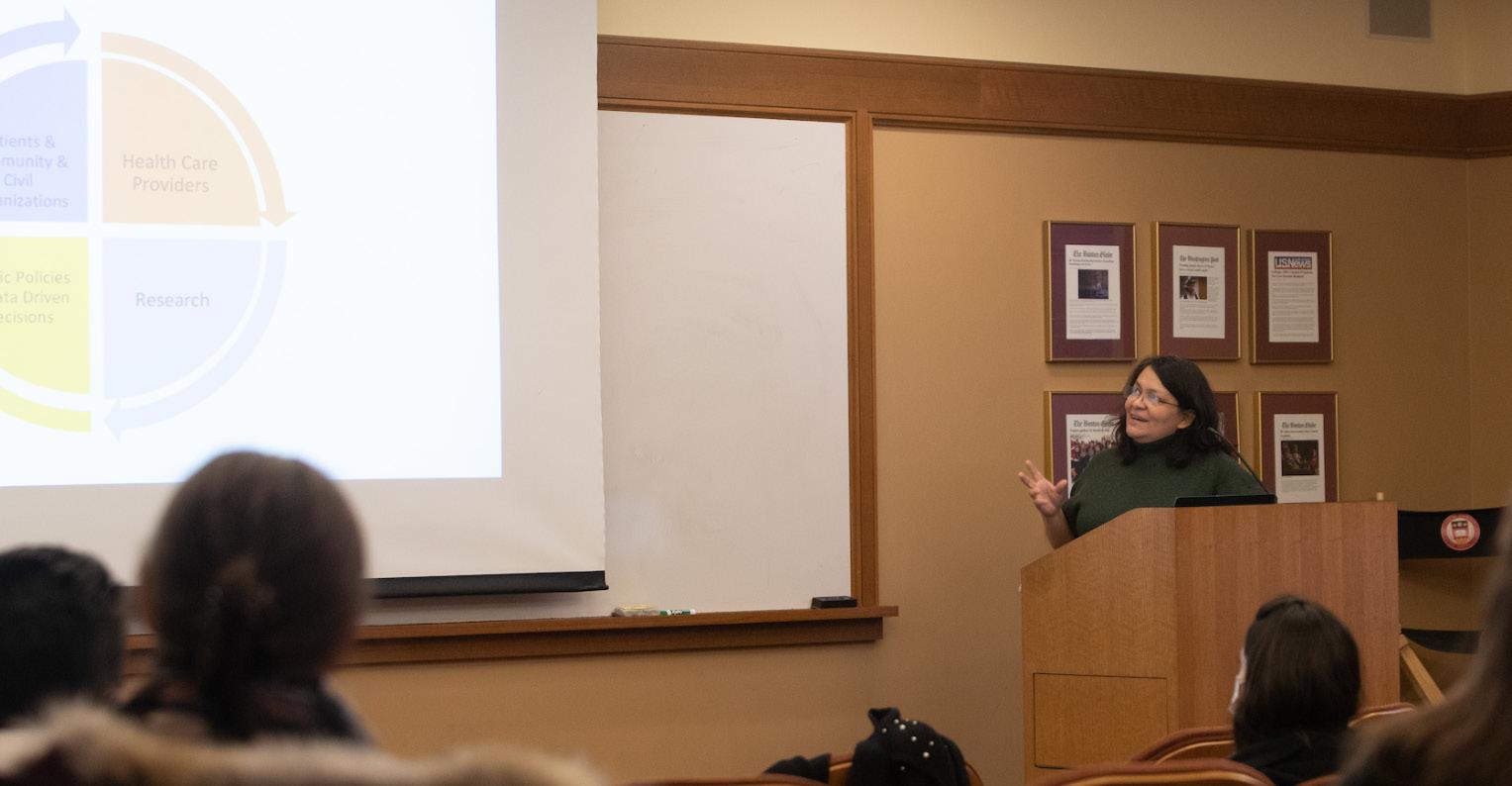
This lecture was the first in the Global Lecture Series, which brings international voices engaged in activism and research to BC.
Five years ago, Calderón Hernández said she hit a funding roadblock in her research.
So, she turned toward previously existing data.
When looking at the data, she noticed a flaw in the way that the health system linked environmental pollutant exposures and health effects.
“There is a huge gap when we try to link exposures with health
effects,” she said. “It’s something that we need to develop strategies [for].”
Calderón Hernández said this discovery guided her research and her journey to BC, where she now works with Philip Landrigan, the director of BC’s global public health program and the Global Pollution Observatory.
“Since February 2020, when I came here, I [started] working on developing this idea of this social digital lab [and] how to create an agenda focused on the prevention of cancer in the children from Mexico,” Calderón Hernández said.
Calderón Hernández’s solution is a proper cancer registry that presents a more holistic view of the complex situation in Mexico.
“In Mexico we do not have a cancer [registry],” she said.
“Sometimes the register only exists [on] paper and in an office.”
Creating a proper registry can integrate information from various health care providers, Calderón Hernández said.
Another issue, according to Calderón Hernández, is that in Mexico, the medical perception is that genetic factors are the main cause of cancer.
“A high proportion—like almost 100 percent—[said] that genetic factors are the main cause, but in the literature the information is that only 10 percent in the case of leukemia … can be explained by genetic factors,” she said.
Former Newton Fire Lieutenant Ray McNamara and other firefighters rushed into a burning H.C. Starck Inc. building on Needham Street in October 1993, when a sudden explosion injured 11 firefighters, McNamara included.
McNamara’s injuries almost killed him, but the firefighter still loved the job, said Mike McNamara, his son and the Deputy Chief of the Newton Fire Department.
“He loved that job,” Mike said. “And he said it many times even after the accident: ‘If I could just get my eyesight back, I’d go back to work.’ He just loved it.”
McNamara, known by some close to him as “RayMac,” died at the age of 79 on Jan. 11, more than 30 years after that injury.
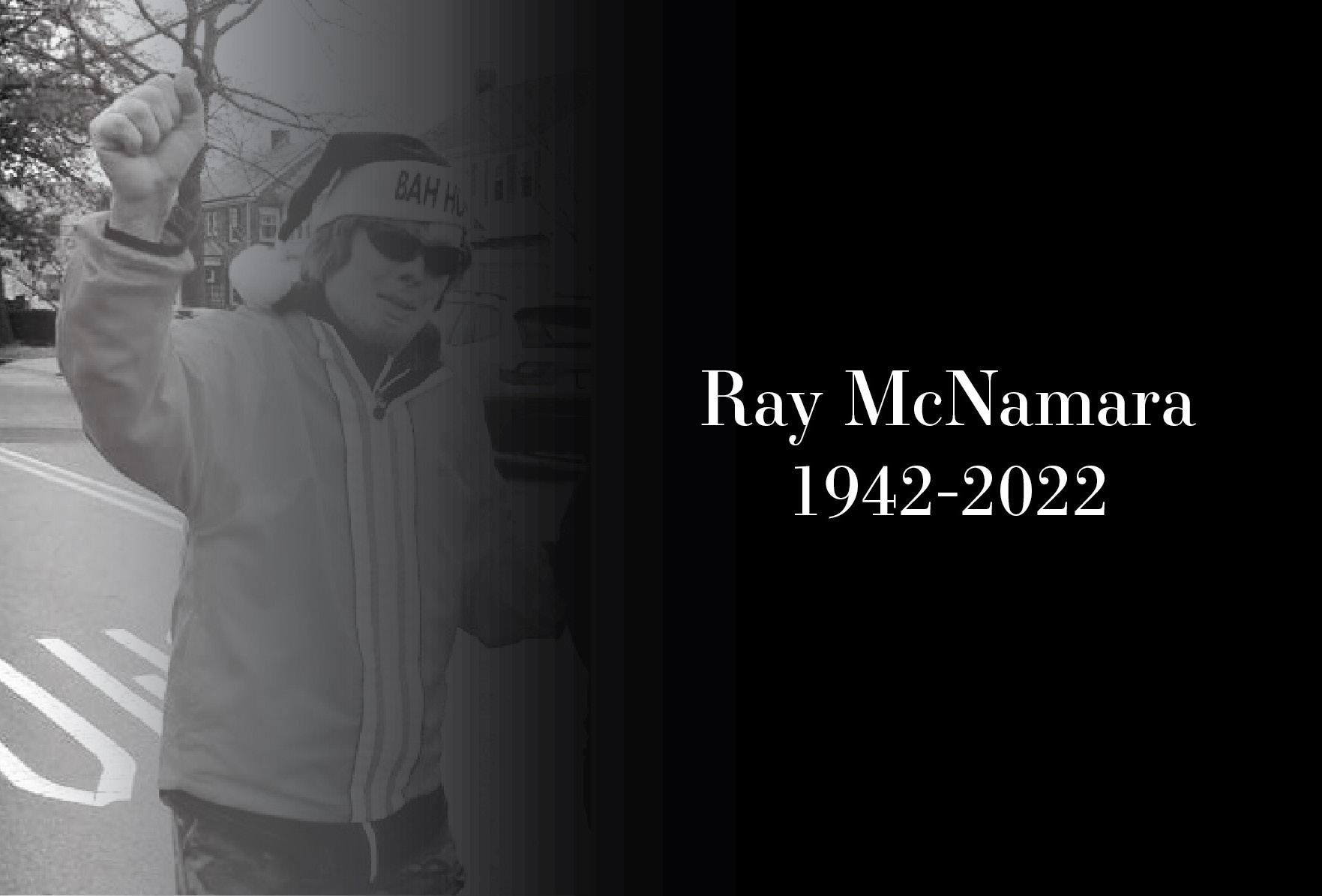
The explosion burned over 90 percent of McNamara’s body and sent him into a coma for 16 months, during which his family had last rites read to him twice, Mike said.
Nevertheless, McNamara survived and continued to be a source of guidance and inspiration to those around him for nearly three decades.
“His love for the profession, his dedication to the department and his fellow fire fighters, and his boundless enthusiasm for life inspired us all,” Newton Mayor Ruthanne Fuller wrote in an email newsletter on
Jan. 13.
Growing up in a modest neighborhood on Derby Street of West Newton, McNamara was one of five children in a large Irish family, according to Mike. Before his career as a firefighter, McNamara spent his early days serving in the Navy and was stationed in Vietnam for two years.
In December 1969, McNamara joined the Newton Fire Department at the age of 27. By 1984, the department had promoted him to
lieutenant, according to Capt. Mark Roche, department historian.
Mike saw his father face numerous challenges in his life, but he said the late lieutenant possessed the grit to overcome them all.
“He’s a hero to me,” Mike said. “He was a no-nonsense guy ... and it’s just amazing, everything that he beat.”
McNamara, at one point, worked three jobs to support his family, sending all three of his sons to college and into military service. Two of them— Mike and Brian McNamara—carried
on their father’s legacy as Newton firefighters.
“He raised us kids,” Mike said. “He worked like three jobs just bringing us up: He was a firefighter. He worked on the side as a medic for a private ambulance. He also did some EMT work for football games for high school. … Not to mention that he also drove a cab once in a while just to make a few bucks.”
But McNamara was a firefighter at heart, Mike said, and his injuries in 1993 robbed him of his beloved
profession.
McNamara lost his sight for over a year as a result of his injuries. He briefly reclaimed it for around a year and a half, only to lose it again.
In addition to the injuries, McNamara also fought two bouts of cancer, according to Mike. Despite his hardships, however, McNamara not only overcame his own obstacles, but also provided solace to others struggling with loss.
“Him and I, every time someone in the fire department’s family member or mother or father passed away, [we] would go to the wakes,” Mike said. “We must have gone to 50 of them just to pay our respects. And it just meant so much to people when he’d walk in. He always had some words of wisdom to say to these people—I don’t even know where he got these words.”
McNamara’s family held a private funeral mass for the late lieutenant on Jan. 15, according to The Boston Globe . A public celebration of McNamara’s life will take place after the COVID-19 pandemic, the Globe wrote.
After his retirement, McNamara continued to impart his enthusiasm and wisdom to future firefighters, according to Mike. Each year, McNamara spoke to graduating cadet classes at a fire academy.
“His big thing that he would tell every one of them was: ‘There wasn’t a day I woke up that I didn’t have a smile on my face just knowing I had that job,’” Mike said n
In response to the rising popularity of last mile delivery services, Newton’s Zoning and Planning Committee explored the city’s options on the services’ regulation at a meeting on Monday.
Last mile delivery services are storefronts stocked with groceries and other goods that individuals can
have delivered to their house within 15 to 30 minutes, according to City Planning and Development Department member Zachery LaMel. Getir, one such business, announced its arrival in Boston in Dec. 2021. These buildings are generally not open to the public.
Current ordinances regard last mile delivery services as retail stores and guarantee them space in village centers as long as they are under
5,000 square feet.
“I’m not opposed to these types of businesses being in the Newton manufacturing districts, … but I think this goes one step beyond that,” Ward 8 Councilor Holly Ryan said. “This ruins the character of our village centers.”
At the meeting, Newton’s Zoning and Planning Committee discussed if the city should allow last mile delivery services to have physical stores
in village centers, and if so, how the city would regulate them through amended zoning codes.
Such stores are becoming increasingly popular in the city of Boston due to the convenience they provide, according to LaMel.
“What we have seen is a rise in these types of businesses as it relates to our desire for bigger speed and bigger convenience,” LaMel said.
LaMel said that while these businesses bring convenience to the neighborhood, they do not foster communal interactions as traditional retail stores would.
When the floor was open for discussions, LaMel and Ward 7 Councilor Lisle Baker discussed the possibility that such stores would ruin the sense of community as well as the foot traffic essential to the villages.
Several other councilors agreed that the loss of community charm is not worth the economic gain potentially created by these businesses, citing the example of the Masonic building.
“It kind of does frustrate me that, for example, the Masonic building … that used to be Newton Books is now a tax company that’s only there three or four months of the year,” Ward 1 Councilor Alison Leary said. “Otherwise it’s just a black window—it’s just a dead kind of place. But they pay the lease every month.”
LaMel presented Fairfax County
and Prince William County, both in Virginia, as models of regulating last mile delivery stores. Both counties amended how they view last mile delivery stores under zoning laws. Fairfax County redefined the use of last mile stores to regulate delivery vehicles in front of the stores.

“Fairfax County really limits the types of the number of vehicles that can be used so that congestion… and this constant scene of cars coming and going is avoided,” LaMel said.
Prince William County similarly redefined the use of the stores to require in-person retail to increase local foot traffic.
“In Prince William County, they had an in-person retail requirement, which … most of these businesses that you’re seeing in Boston and Cambridge just don’t have,” LaMel said.
The committee ended the meeting by voting no action necessary and created a new docket item to revisit the zoning amendment at a later date.
LaMel cited a previous outreach effort in the city where citizens expressed their desire for community.
“Based on the recent engagement that was done last year, the community voices that we heard made it quite clear that they are looking to see a more active village center,” LaMel said. “Regulating these kinds of last mile delivery services would be consistent with that image.” n
The City of Newton reported fewer COVID-19 cases during the week of Jan. 20 to 26 than in previous weeks, suggesting that the Omicron peak may have passed in the city. Newton Mayor Ruthanne Fuller outlined several figures that suggest that the variant is beginning to loosen its grip on Newton in a newsletter update on Jan. 27.
During the week of Jan. 20 to 26, 675 Newtonians tested positive for COVID19–a decrease from 969 total cases the previous week and 1,156 total cases the week before that, according to Fuller’s Jan. 27 newsletter update.

Even with declining COVID-19 cases and hospitalizations in Newton, another three residents died from the virus, Fuller wrote.
“We lost three more Newtonians who died with COVID-19, another reminder
that even as the Omicron surge appears to be abating, the virus continues to take a heavy toll,” Fuller wrote.
Newton’s 14-day positivity rate from Jan. 9 to 22 dropped to 6.7 percent. The two-week positivity rate was 11.2 percent just a week prior, Fuller wrote in a previous newsletter.
The downward trend is also reflected in case numbers at Newton Public Schools (NPS). In the NPS community, 199 students and 28 staff members tested positive from Jan. 20 to 26—a total of 227 individuals, according to its dashboard.
In the week prior, 317 students and 46 staff members tested positive, the dashboard reported.
At Newton-Wellesley Hospital, hospitalizations for COVID-19 in Newton are no longer increasing. On Jan. 14, the hospital cared for a peak of 56 patients with COVID-19, Fuller wrote.
“Newton-Wellesley Hospital, as of Tuesday, Jan. 25, reports they are caring

for a total of 48 patients hospitalized with COVID-19, two (2) of whom are in the ICU,” Fuller wrote.
The hospital admitted 40 percent of those 48 patients because of their COVID-19 diagnosis, Fuller wrote.
Kristin Cox, the director of quality and safety at Newton-Wellesley Hospital, compared the Omicron surge to past pandemic peaks.
“Compared to the surge from last winter, … we’re seeing about the same number of people who are hospitalized with COVID-19,” Cox told The Heights
“But, in general, they are much less sick, which is partially related to vaccination and partially related to the strain of illness and specific treatments that are available.”
The high infectiousness of the Omicron variant, though, poses a challenge for the hospital as it confronts staffing issues, according to Cox.
“The other way this [variant] has been different is more employee infections, and while they’re mild illnesses, it causes some disruption in staffing, so that was a different challenge,” she said. “[It is] more disruptive than we had seen in other surges.”
Cox said it is hard to determine what a future surge may look like.
Even if a next surge is milder than the Omicron surge, Cox said she hopes community members continue to use prevention measures such as wearing masks and receiving vaccines and boosters.
“New strains are ever evolving, and the next strain could be less infectious or more infectious, and it could cause more serious illness or less serious illness,” Cox said. n
The Newton Police Association was the only city union that chose not to sign a memorandum agreeing to comply with the vaccine mandate.
“I am grateful to all of our union leadership who spent many hours and days talking about this important workplace safety initiative,” Fuller wrote. “It was important to me as Mayor to include our unions in conversations about the impact of this policy.”
The City is providing a one-time stipend to every full-time union and non-union employee who complied with the vaccination policy, according to the newsletter.
“Those who worked through the most challenging months of the pandemic will receive a stipend of
$1,500. Employees who joined our team more recently will receive $500,” Fuller wrote in the newsletter.
Federal law mandates that because they opted out of signing the memorandum, members of the Newton Police Association will not receive stipends, Fuller wrote.
The funding for the stipends will be provided with American Rescue Plan Act funds totalling approximately $1 million, according to Fuller.“Again, I am so grateful to our employees, ‘’ Fuller wrote.
“During the 22 months of this pandemic, they have been committed and caring, working in person if their job required or pivoting to working from home. They worked long hours under trying circumstances while balancing the needs of their own families with the needs of Newtonians.” n
The intersection of Arlington St. and Crawford St. in Watertown is a slow and quiet residential area.
What Da Chick, a new Thai chicken restaurant with bright yellow walls covered in pictures of cartoon chickens, acts as a beacon of light on the otherwise gray street corner.

Opened on Nov. 9, What Da Chick specializes in khao man gai, a traditional Thai chicken rice.
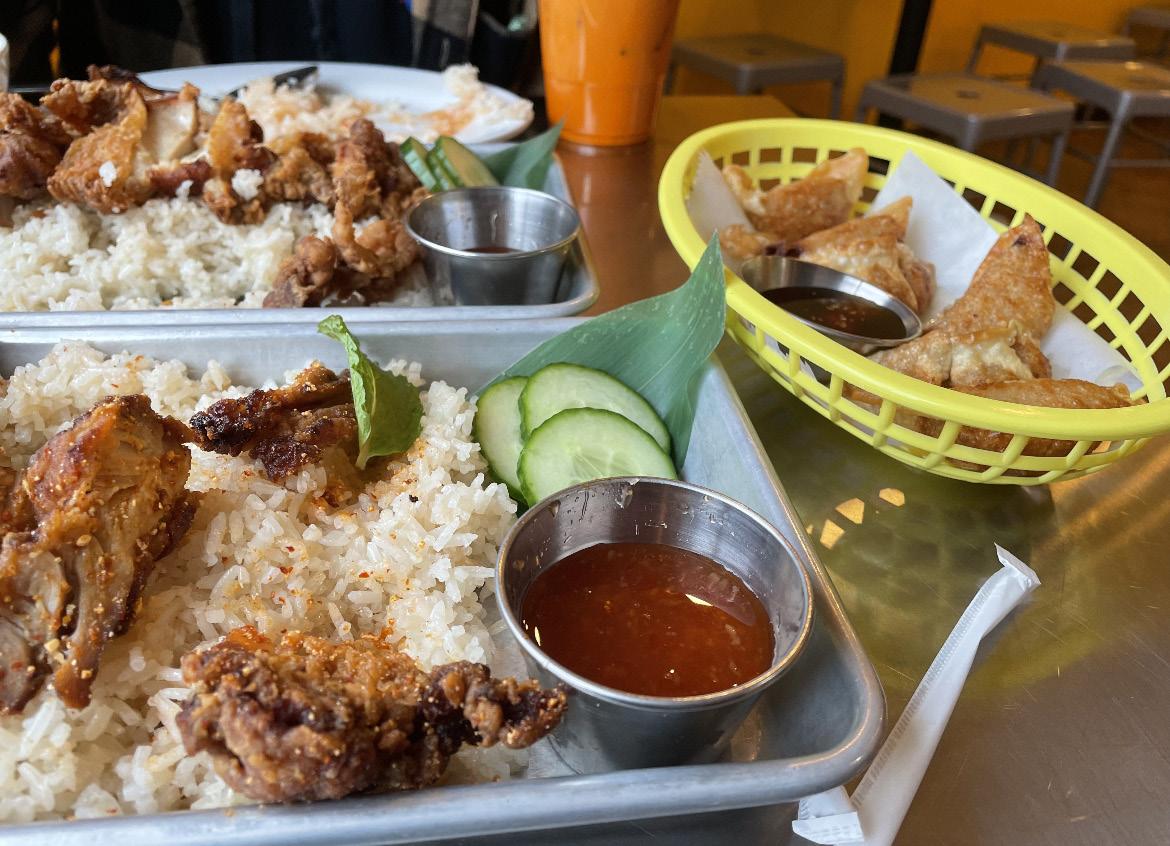
“Thai-style chicken is so new around here,” said Natapat Jansipsee, a line cook at What Da Chick.
in Thailand.”
What Da Chick strives to be authentic in the food it serves.
Its menu attracts many people of Thai heritage to the restaurant as well as those looking to expand their cultural palate with new worldly cuisines, according to Jansipsee.
“It’s an old school [meal] for everyone,” Jansipsee said. “It’s everywhere, in every culture, and every culture is different. … We want to set up the vibe straight away that this is very authentic, very Thai, very warm, welcoming, and family-oriented.”
Just like vendors one could find on the streets of Thailand, What Da Chick
and a few appetizers, but each option is packed with flavor.
“The place screamed that it was fun, new, and not too serious about itself, which was cool,” AJ Singh, a diner at What Da Chick, said.
“Everyone was really nice, and the food was really good—definitely some of the best Thai food in the area.”
One of the restaurant’s most popular dishes, according to a hostess, is the spicy chicken rice.
The dish includes What Da Chick’s basic fried chicken coated in a chili powder that is unique to Thailand and gives the dish a slightly more acidic and spicy flavor.
The fried exterior provides a nice crunch and texture to the chicken without feeling too greasy.
“[The food] had flavors that I could see everyone enjoying,” Singh, CSOM ’23, said.
“It wasn’t like you had to love Thai food to be there.”
Along with traditional ginger rice, each chicken dish comes with a different dipping sauce to complement the flavors of the chicken.
The spicy chicken comes with a sweet chili sauce that cools down the hint-of-lime spice with a honey-like sweetness.
What Da Chick also serves a lighter, roasted chicken option.
Each meal also comes with a bowl of Daikon soup, a traditional Thai starter made from radishes and chicken stock.
The soup feels soul warming and might even remind you of your mom’s chicken soup.
What Da Chick offers a variety of appetizers, including fried chicken or
of What Da Chick chicken—poached, grilled, and fried—six servings of Daikon soup, and two portions of each sauce—ginger, sweet chili, and tamarind.
No matter which chicken style you decide to go with, What Da Chick brings the flavor and comfort of tradi-
“The restaurant vibe is very streetlike—you could find something like this
offers a limited menu of Thai comfort food with just five chicken rice options
The dish comes with a lemon tamarind sauce, which adds a gingery flavor to the meal.
vegetable gyoza for a warm option and a seaweed or house salad for a cold starter.
The restaurant also serves traditional Thai drinks such as Thai iced tea, longan juice, and roselle juice.
To further emphasize its focus on family and community, What Da Chick offers a combo family meal for larger groups, including all three styles
tional Thai street food to the people of Watertown for a reasonable price.
The spicy chicken rice costs $12.95, according to the restaurant’s website.
“We want all the guests to feel at home and in a cozy environment,” the hostess said.
“We can serve flavorful food and special family combos for everyone so that everyone feels welcome here.” n

Every January, countless people worldwide decide they are going to become a “new person” in the coming year by changing their old habits and forming new ones. This especially applies to college students and their forthcoming spring semesters. Between wanting to perform better academically, exercise more, or procrastinate less, there are countless promises students make to themselves that often fall through. Instead of only sticking to your resolutions and goals for a couple of weeks, here are some tips to ensure that you stick to your resolutions throughout the semester (and potentially the whole year) …
To begin, set specific goals.
A mistake that people often make when forming their New
Year’s resolutions is forming too many vague goals. In order to combat this issue, you should make a list with areas of your life that you can improve, then choose one to five goals to really focus on. This way, it will be easier to keep track of them. In the New York Times article, “How to Make (and Keep) a New Year’s Reso lution,” Jen A. Miller dis cusses how goals should follow the SMART guideline— meaning they should be specific, measurable, achievable, relevant, and time-bound.
By ensuring that your goals check each box, you will be more likely to reach success in your resolution efforts.
Clarify your definition of success and be patient with yourself.
In order to map out your steps to success, you must first define
“success” in your own words to see how attaining your goals will satisfy you. Be clear with what

tion, see how some of the world’s most successful people define their success in the article “How 9 Incredibly Successful People Define Success” by Drake Baer. Keep in mind that permanent change takes awhile to build and that success isn’t built overnight.
Invest in a planner.
Regardless of whether or not your resolutions involve scheduling, a planner is a great way to ensure that you are on track with forming new habits. Whether it be calling home more, going to bed earlier, or increasing class partic-

ipation, a planner can help keep track of the frequency, dates, and times of your habits. A personal favorite are the planners from Plum Paper, where you can customize your planners down to the nitty gritty, including your course names and extracurricular activities. Other top-notch planners include Anthropologie, Agendio, and Golden Coil. For those who are more tech savvy, Google Calendar, MyStudyLife, and Things 3 are three user-friendly platforms that eliminate the need for pen-andpaper planning.
Find an “accountability buddy” that has similar goals as you.
In college, there are inevitably several friends and peers that have the same goals as you for the upcoming semester. By finding a friend to form new habits with and to hold yourself accountable to, your motivation to stick to your resolution will increase.
For example, find someone who will go to the gym with you

for a workout or a study buddy to accompany you to O’Neill.
Set rewards for reaching milestones along the way.
Lastly, it is important to reward yourself during your journey to keep your motivation up. The more you divide up the timeline for reaching your goals, the more encouraged you will be in the process of successfully completing your resolutions, since you will feel like you are consistently reaching milestones.
For example, if you are working hard at the gym, treat yourself to a fun workout class at Soul Cycle or Barry’s bootcamp! If you are trying to better your time management, reward yourself with a leisure activity. Rewarding yourself for reaching smaller goals will increase your stamina to fulfill your resolutions. n
 B y J ohn K alil Heights Staff
B y J ohn K alil Heights Staff
Homer’s Iliad tells the story of mythic Greek soldiers like Achilles and Odysseus sieging the city of Troy in search of kleos—Greek for “renown” or “glory.” Homer’s exact birthplace is of scholarly debate, but some place it on the island of Chios. Now, roughly 29 centuries later, this same island is a key site in entrepreneur Effie Panagopoulos’ own search for kleos.
Chios’ main claim to fame, other than Homer, is the production of mastiha, a type of resin gum derived from an eponymous tree and known as the “tears of Chios.” The European Union recognizes the superfood as a product of Protected Designation of Origin, which can only be cultivated on Chios.
Panagopoulos, BC ’99, said she grew up in a Greek immigrant family in Boston and enjoyed mastiha by the spoonful as a dessert in her youth. In the summer of 2008, Panagopoulos had a fateful encounter with the flavor at a beach bar in Mykonos.
“I had a Proustian rush,” Panagopoulos said. “I tasted this alcohol that everyone’s doing shots of—all these American tourists. I try it and I’m like, ‘Oh my God, I know this flavor profile. This is delicious. Why the hell don’t we have this in the United States?’”
After a winding career path following her graduation from Boston College, Panagopoulos had finally found her calling in life—to bring the distinctively Greek mastiha liqueur to the American consumer.
“When I had this eureka moment, I literally felt—and I feel still today—that
this is my fate, that I am meant to do this,” Panagopoulos said. “I’ve never felt so strongly about this in my life.”
Panagopoulos graduated from Boston Latin School in 1995, where she studied Latin, Greek, and French. Then, as an undergraduate at BC, Panagopoulos said she took a theology course with Rev. Ronald Tacelli, S.J., who gave her an impactful piece of advice.
“I’m never going to forget this line,” she said. “He said, ‘Study what you love, and the career will follow,’ and I think it’s the best advice that I’ve ever received.”
Having developed a passion for lan guages at an early age, Panagopoulos majored in French with minors in Span ish and Italian in the Morrissey College of Arts and Sciences. She aspired to be come a U.N. ambassador, but Panagopo ulos said she focused more on the social opportunities at BC and less on finding internships and preparing for her career. After growing up in an extremely strict immigrant household, Panagopoulos said she fully enjoyed her college experi ence because of the heightened sense of independence.
One of Panagopoulos’ college jobs introduced her to the alcohol industry— the industry in which she would eventu ally make a name. During her junior and senior years at BC, Panagopoulos was the only female employee at the former Brighton bar Mary Ann’s.
“There were a lot of big, burly, foot ball-watching, buffalo wing–eating guys that worked there, and me,” Panagopo ulos said.
After graduating from BC, Panagop oulos said she experienced a career cri sis, unsure of what she wanted to do. She eventually took a job teaching Spanish at
Dedham High School.
“That job gave me gray hair in my first year, being 21, and the kids were like 16, 17 years old,” Panagopoulos said. “So you can imagine what it’s like being a really young teacher. It was a romper room.”
Panagopoulos decided that teaching was not the vocation for her, and she took a job at Univision, an American television network for a Spanish-speaking audience. There, she put her language skills to work, translating English advertisements and commercials into Spanish.
All the while, Panagopoulos moonlighted as a sales representative for various brands in the liquor industry, doing tastings at bars and events. Panagopoulos said she enjoyed her night job more than her day job and grew tired of the nine-to-five style of work at Univision. Hoping to make a career pivot, it took over two and a half years of persistence to land a full-time job in the alcohol industry, she said. After accepting a transfer to Las Vegas with Univision, Panagopoulos received a job offer as a brand specialist for Bacardi in San Francisco.
“I moved to San Francisco, sight unseen, packed a U-Haul with my car attached to the back, and drove … to San Francisco,” she said. “I had never even been to the city before.”
At Bacardi, Panagopoulos said she helped relaunch Grey Goose vodka and Corzo Tequila. She said Rémy Cointreau, the owner of Metaxa, the world’s largest Greek spirit brand, subsequently recruited her as a national brand ambassador. It was this job that sent her on a business trip to the jet-set island of Mykonos, bringing Panagopoulos to her eureka moment.
It would be 10 years, however, before Panagopoulos officially launched KLEOS, her brand of mastiha liqueur, as the first Greek woman to self-start a spirit brand.
Panagopoulos initially consulted for
a different brand of mastiha liqueur, finding that brand’s own importers and distributors in the U.S. Panagopoulos said, however, she received a pittance in salary and no equity in the company.
“It’s the tried and true story of being a woman and not getting paid what we rightfully deserve,” Panagopoulos said. “That was for me the moment where I was like, ‘You know what? I think I can do this by myself. And I think that I can also improve upon the category and really create a luxury brand.’”
Panagopoulos spent five years researching and developing her new mastiha liqueur. She said she worked with six different distilleries to develop 17 different formulas which went through countless focus groups. According to Panagopoulos, the final KLEOS product strikes a perfect balance—dry enough for high-end bartenders and sweet enough for the average consumer.
“You have to have a really strong idea of who are you selling to and what are those people looking for?” Panagopoulos said. “Does your product actually resonate with the people that you think are going to be the ones that are going to buy it?”
After nailing down her product, from the taste of the liquid to the shape of the bottle, Panagopoulos said she struggled to find venture capital for her startup.
sential.
By Mc cLaverie Assoc. Magazine EditorAlmost two years into the pandemic, I finally received the dreaded 617 call—I had tested positive for COVID-19. In a panic, I rushed to pack as quickly as possible, throwing whatever I could into my suitcase and blue Ikea bag.
For me, this was my first time heading off to Pine Manor, and I had no idea what to pack or what to expect. Here are my tips and tricks for surviving Pine Manor and making your quarantine the best it can possibly be.

So, what actually happens when you test positive?
After you test positive for COVID-19, everything happens quickly. Take a deep breath— it is going to be okay. Notify your family and roommates that you have tested positive and start packing.
University Health Services and ResLife will both be in contact with you to coordinate transportation to Pine Manor. If you live nearby and plan to quarantine at home instead, make sure to notify ResLife that you will not need transportation to Pine Manor.
If you live off campus, you have the option of quarantining in your off campus house or apartment instead.

The time between testing positive and arriving at Pine Manor is the most stressful part of the whole experience, so try to keep a level head to ensure you don’t forget to bring anything es-
Most students have around an hour to pack before the Eagle Escort picks them up to bring them to Pine Manor. Once you are there, most rooms contain at least one bed, dresser, desk, closet, fridge, and microwave. They also provide a pillow, a towel, an extra blanket, and sheets for you.

Although the rooms are actually fairly nice, I still recommend bringing a few extra things to make the experience a bit more comfortable. I brought two extra blankets, my pillow, and a towel to make my room feel more homey. Although it was lacking in comparison to my cozy eight-man suite, those personal items helped me feel much more comfortable.
For those of us who haven’t had to use a communal bathroom since freshman year, it can be jarring to
temperatures in your room, as well as various pairs of sweatpants and pajama pants. I brought my slippers to wear in and out of the bathroom and a few pairs of socks. Make sure to bring a jacket as well for outdoor time if you want to take a few walks to escape the confines of your room.

Being in Pine Manor means returning to Zoom classes, so make
mentally taxing experience. My biggest piece of advice is to stick to some sort of routine to maintain a sense of normalcy. A big part of this is maintaining a consistent sleep schedule. The temptation to stay up at night and sleep in or nap during the day is strong, but going to sleep at a regular time will help ensure that you stay on track and easily transition back to life on campus when you return.
I used my spare time in quarantine to call my family and home friends, which can be difficult with all of the stress and busyness of school and extracurricular activities.
or if you don’t like what is served for dinner, you can always order food via delivery service or Instacart, as long as it arrives before 8 p.m.
I recommend ordering more than one meal and versatile groceries, such as peanut butter and cheese sticks, to store in your fridge in case the lunch or dinner options don’t appeal to you. You will receive instructions to give the delivery drivers so they know exactly where to deliver your food.
revert back to one, even if it’s temporary. I cannot stress it enough—bring shower shoes.
The bathrooms get cleaned twice a day, but for extra precaution, you should grab whatever pair of flip flops, slides, or other shower-friendly sandals you might have and pack them in your bag, along with your essential toiletries. Clothing-wise, there is no need to pack anything besides loungewear. I would recommend bringing a few sweatshirts and t-shirts, in case there are varying
you pack all of the notebooks, textbooks, and folders that you might need to attend your classes and do your schoolwork remotely.
It is important to communicate with your professors how long you will be in quarantine, when you will get out, and how you are feeling. Open and honest communication between you and your professors will ensure that you stay caught up on work while you recover.
My last, and potentially most important, item to pack for Pine Manor is snacks. I grabbed Clif bars, Goldfish crackers, and some gummy candies for variety. Having some extra snacks to munch on during the day while in Zoom class or at night while binge watching a show is always a bonus, so bring some from home if you can.
Being alone in isolation can be a
Back at school, my friends made an extra effort to reach out and make sure I was feeling okay.
A few of my friends called to check in and fill me in on what I was missing on campus.
Staying connected through text, call, or even social media can be a great way to pass the time and keep you from getting too lonely in isolation. One of the biggest mistakes I made during my stay at Pine Manor involved food.
Everyday, you must order your food for the next day on the GET Mobile app before 3 p.m. On GET Mobile under “Isolation Meals” you can choose between two dinner options and two lunch options.
The isolation meals also provide breakfast for the next morning, some other snacks, and water bottles. The first day I was in Pine Manor, I forgot to do this and ended up not having food.
If you make the same mistake I did,
Lastly, don’t be afraid to reach out to ResLife. They give you a number that you can call or text at any point if you need anything. I asked them for coffee every morning, and someone on staff brought it to my room.
If you need snacks, more water bottles, or deliveries picked up, someone will do it for you. ResLife will also offer to pair you with a conversation buddy, which I could not recommend more.
Speaking with my conversation buddy was always one of the highlights of my day, as we got to know each other and talked about various topics, ranging from TV shows and movies to how we have the same initials.
No one wants to test positive for COVID-19 and be sent to Pine Manor, but I hope my tips and tricks can help make the transition and experience a little more pleasant.
Keeping an open mind, staying flexible, and trying to stay positive about testing positive will make the experience much better and allow you to survive Pine Manor in stride.n
GRAPHIC BY LIZ SCHWAB / HEIGHTS EDITORBoston College professor Henry Braun received the American Educational Research Association (AERA) E. F. Lindquist Award for his research, which has focused on studying inequality in education and testing, on Dec. 7, 2021.
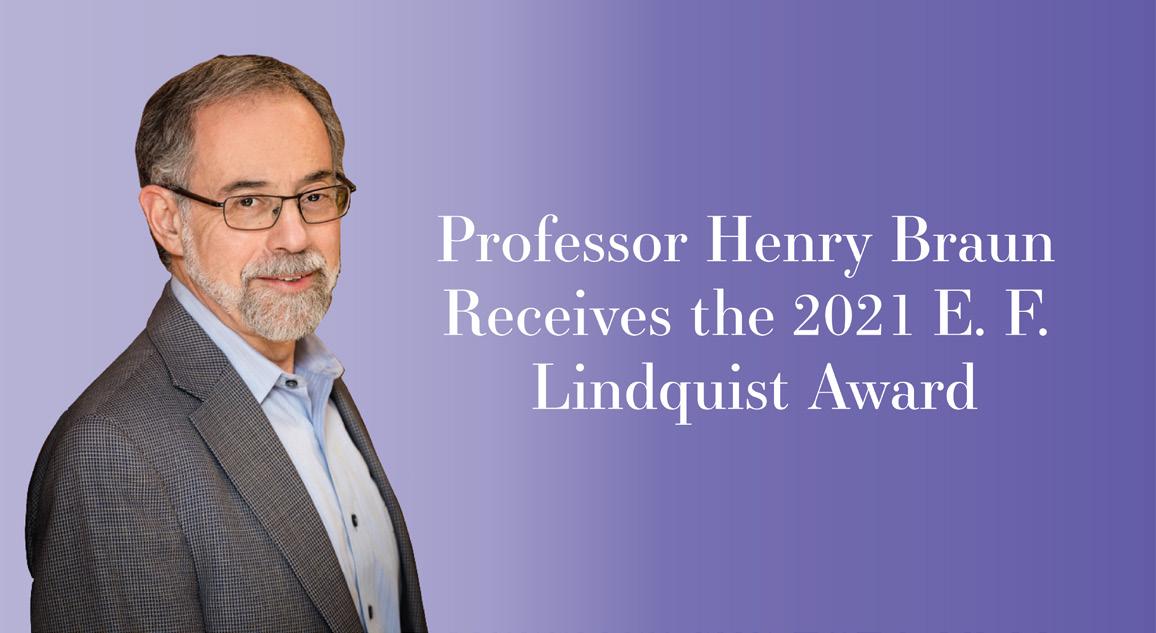
Named after Everett Franklin Lindquist, the annual award recognizes outstanding applied or theoretical research in the field of academic testing.
The award is meant to acknowledge a body of research of an empirical, theoretical, or integrative nature.
“[Receiving this award] was a bit of a surprise because this is a type of career award,” Braun said. “I mean, it’s in the name of a very famous measurement. E.F. Lindquist actually founded the ACT … so winning an award named for him is very gratifying.”
Braun is currently the Boisi Professor of Education and Public Policy at BC’s Lynch School of Education and Human Development, and the director of the Center for the Study of Testing, Evaluation, and Educational Policy.
Braun is originally from Montreal, Canada, where he earned his bachelor’s degree in mathematics at McGill University in 1970.Braun said he discovered his interest in statistics during his time as an undergraduate.
“I was exposed to statistics in my
junior year and really enjoyed that and saw statistics as a way of developing a set of tools that I could use in lots of different areas, which I thought I would be able to [use to] work in different areas rather than just one area,” Braun said.
Braun went on to receive his Ph.D. in mathematical statistics at Stanford University in 1974. He then began his professional career teaching in the statistics department at Princeton University before moving across the street from Princeton to work as a scientist for the Educational Testing Service (ETS).
While at ETS, he was promoted to a director of research then to vice president for research. He eventually retired from this role to become an education policy researcher.
Braun said he is appreciative of the breadth of skills he has gained and projects he has managed in his various roles, from technology-based licensing tests for architects to studying the quantitative problems that come up in the world of academic testing.
His later work had a strong focus on education policy, which he has continued to study throughout his career.
Braun said that one of his major research projects at ETS was studying intergenerational mobility—the impact of the socioeconomic status of parents on the future status of their children.
“[At ETS, we were] trying to un-
derstand the lack of intergenerational mobility in the United States,” Braun said. “We worked on issues of trying to understand quantitatively how opportunity works. How the lack of differences in literacy and numeracy among different populations, how that will contribute to the lack of intergenerational mobility. So, that was a whole line of research that was quite separate from testing.”
After 27 years at ETS, Braun retired in 2006 and joined BC’s faculty in 2007. He said that he decided to move to Boston to be closer to his two daughters who had both settled in the city.
He accepted the position at BC because it allowed him to easily balance teaching part time and conducting research.
“I was interested in returning to academic life, and BC offered a position that gave me what I thought would give me a lot of flexibility in terms of what I could do as a researcher and also return to teaching, which I always loved,” Braun said.
Braun typically teaches three graduate level courses in Lynch: Topics in Mathematical Statistics, Assessment Design, and a course about educational policy.
Gulsah Gurkan, Braun’s most recent doctoral student, said his close relationships with his graduate students testify to his commitment to teaching.
“He’s a distinguished scholar and
has been working in the field of educational testing and policy for years, so his expertise is indisputable,” Gurkan said. “Even though he’s such a wellknown figure in our field, he’s been very accessible to the students, and you feel like you can reach out to him. And I think for his classes, he only tries to improve them, even though he’s been teaching for years.”
Professor Larry Ludlow, the current chair of BC’s department of measurement, evaluation, statistics, and assessment, and a good friend of Braun’s, also highlighted how Braun’s approach to teaching makes statistics much more accessible.
“He’s caring and sensitive, and has never been a pretentious, arrogant statistician … when it’s so easy to make someone feel stupid,” Ludlow said. “He understands that you have to get down
to the knowledge level of where the individual was at before they’re going to be able to learn from you.”
Ludlow also praised his teaching abilities from an administrative standpoint.
“He is involved with state-of-the-art developments in assessment measurement and large-scale testing in general,” Ludlow said. “And these experiences lead him into the classroom with topics about what is going on and where the future of educational assessment and testing is going, and this is exactly what I need for our doctoral students because he is an aspiring lecturer.”
‘The Mad Ones,’ from A1
Standing before audience members as they trickled into the blackbox theater was a three-dimensional version of the images Baker had laid out in her journal. A gray board sat in the center of the stage with its surface fragmented by triangular pieces. Vibrant LED lights lit up from behind the pieces. In front sat the steely outline of a car.
The musical opens with Samantha (Giovanna Befeler, MCAS ’23) singing “The Girl Who Drove Away” in front of a backdrop reminiscent of an explosion. Up until her senior year of college, Samantha’s life had been complicated yet planned to a T. She had the same boyfriend, Adam (Nick Rossi, MCAS ’23), for the past three years and an overbearing mother, Beverly Brown (Julia Parks, CSON ’24), who was hellbent on having Samantha follow in her Ivy League footsteps.
But Samantha’s world imploded when her best friend Kelly Manning (Abby Wachter, MCAS ’25) died in a car crash during their senior year.
What was supposed to be a year full of memories turned into a year of reflection for Samantha. Already questioning whether she should attend college or stay with her boyfriend, the death of the one person who made her feel free made Samantha want to embark on her own adventure instead of dealing with an uncertain future.
The musical, as a whole, deals with the heavy topic of loss, but there are strong comedic moments interspersed throughout as Samantha deals with other characters in her life. In Adam’s humorous ballad “The Proposal,” he pleads to Samantha “Won’t you please have sex with me? / I make great Darjeeling tea.”
Between Winter Break interrupting rehearsals and the COVID-19 pandemic, the production process was far from simple. The cast’s first week of rehearsals took place on Zoom due to a cast member testing positive for COVID-19.
Since the cast had to rehearse the music over Zoom, Emma Roney, the music director, sound designer, and MCAS ’22, used sample tracks of
the songs and isolated each actor’s vocal parts from the tracks to make it easier to learn their individual parts. Roney also gave each actor the track with every vocal arrangement except theirs on it—making it so they could hear how their voices sounded together without singing at the same time or in the same room.
“I mean, I think our cast was so talented, that it was easy because they were quick learners,” Roney said.
The music Roney directed coincided with the changing feelings of Samantha throughout the show. When Samantha alludes to Kelly’s tragic car accident, a beat like a heartbeat plays in the background. Similarly, the light emanating from the gray shards in the backdrop changes based on the characters’ emotions or the story they recounted. When Samantha voices her frustrations about her mom, the light turns pink, the color of love.
Even though Samantha gets annoyed with Beverly, her love for her
mother still shines through in this moment. As Beverly talks about the stress of teaching Samantha how to drive, the lighting becomes brighter and more intense to match her increasing anxiety.
The actors in The Mad Ones entered the stage from all directions, but typically congregated near the car prop that remained the focal point of the set.
The persisting presence of the car shows that in order to solve the other problems in her life, with her boyfriend and her mom, Samantha has to acknowledge the one that causes her the most pain, no matter how hard she tries to avoid it.
As the actors faced the challenges of the rehearsal process together, the four-person cast each stepped up individually to dive into their character study and also forged a close bond with each other, Baker said. Wachter agreed that the four cast members were able to forge close connections through the intense production process.
“It was a really tight-knit group, and we were all just really supportive of each other,” Wachter said. “And [we were] all working really hard. The hours were long … but I think that the group that we have made it possible to work under these circumstances.”
The show came together with only 14 days of rehearsals before they began dress rehearsals.
Not only did the cast and crew connect over the story they were telling, but the musical’s theme of figuring out your path in life is relatable to a college audience.
As a college senior, Baker said that the show resonated with her as she approaches a new phase of life.

“I get uncomfortable watching it sometimes because I literally can see myself having these [same] conversations and can see myself in these characters, which is a good thing,” Baker said. “And you know, I don’t think theatre is supposed to make us feel comfortable. But, it’s really exciting.”
Two feet of snow on the ground couldn’t stop UPrising Dance Crew from holding its “Waves V” showcase on Saturday night. Leaving snowy footprints behind, audience members streamed into Robsham Theater for the high-energy performance, which also featured three other Boston College dance groups—Synergy Hip Hop Dance Company, AEROdynamiK Dance Crew (AeroK), and Phaymus Dance Entertainment.
Two other hip-hop groups originally planned to perform at the show but had to cancel due to the snowstorm: Queens
With a Mission (QWAM), an all-male dance team from a dance studio in Malden, Ma., and UPro, a group from Boston University that combines Asian music and American hip-hop culture.
The two masters of ceremonies, Madelyn Schwartz and Madeleine Bamberger, both MCAS ’24, welcomed the crowd, noting that the show was the fifth annual “Waves” showcase and marked UPrising’s 10th anniversary.

Red lights bathed the stage in an eerie glow as the UPrising dancers assembled across the width of the stage to kick off the show with a routine from the fall season. The audience swelled with cheers as the bass beats pounded, and the dancers moved in synchronized formations
across the stage.
The first set also included acting elements, as two dancers held umbrellas and played out a romantic scene in the rain. The UPrising team made quick transitions on and off stage, all the while moving mesmerizingly in sync.
Phaymus came onstage next, dancing to “Love Doctor” by Romain Virgo. The grouWWp mastered quick transitions, as songs shifted from deep bass sounds to more high-energy tunes. In one dramatic moment, the lights went down onstage so that only the silhouettes of the six dancers were visible against the backdrop.
Synergy started its set with the song “Best Friend” by Saweetie as the danc-
ers created a pyramid formation. Their matching white sneakers shined under the stage lights—highlighting each dancer’s precise footwork. The audience sat mesmerized as the dancers moved in unison with isolated popping motions to the beat of the music. The senior dancers in UPrising then performed to a compilation of popular songs, including “Shot Clock” by Ella Mai.

The lights went up in the theater for intermission, and the hosts asked for audience members to participate in a dance battle with an El Pelón Taquería gift card at stake. One member each from Phaymus, Synergy, and UPrising showed off their improvisation skills as the audience cheered them on.

After intermission, UPrising’s rookies performed and gathered around as a dance battle unfolded among them. Next up, AeroK took the stage after taking a hiatus from performing together due to the COVID-19 pandemic. The large group exploded onstage, weaving into different formations and switching be-
tween powerful, precise movements and looser beats.
Then, the full UPrising cohort returned to perform a final set titled set. With coordinating black and white costumes, the dancers sectioned off into three alternating groups.
Just when it seemed the show was about to end, Schwartz and Bamberger introduced the last act, welcoming all four dance groups back onstage for a collaborative set.
The groups took turns taking the stage for a final dance before members of all teams came together. Dancers created a circle around the edge of the stage as a member from each crew stepped into the middle to dance to “Don’t Waste My Time” by Usher.
The music stopped and was replaced by the rhythmic stomping of the dancers onstage as they created their own beat. Cheering among themselves they all danced toward the center of the stage. The performers created their own energy and warmth on a snowy night.
 By Paterson tran Asst. Arts Editor
By Paterson tran Asst. Arts Editor
Set in the present day, the movie follows a group of teens who are all related to the characters in the first four Scream movies. Their connections to the killings that were at the center of the first four films immediately brew conflict and suspicion when Tara (Jenna Ortega) is attacked by someone impersonating Ghostface, the recurrent killer in the series. In typical Scream fashion, a hunt to find the identity of Ghostface and the motive behind the copycat killings ensues.
Familiar archetypes of horror movies appear throughout the film, including the grudging elder role that falls on Dewey Riley (David Arquette) from the 1997 Scream 2 release. Since Dewey survived several iterations of the franchise, Tara’s estranged sister Sam (Melissa Barrera) and her boyfriend Richie (Jack Quaid) track Dewey down to gather his insight on serial killer patterns and motives. In its two-hour runtime, Scream
replicates the plot formulas of its previous films, which is a common strategy in the horror genre. The movie, and the franchise as a whole, however, makes up for its storytelling shortcomings with its indulgence in cliché themes and plot twists. The series has always branded itself as self-aware of its horror tropes.
Scream’s approach takes the form of jokes about the killer usually being the unassuming boyfriend—toeing the line between comedic self-awareness and overdone annoyance.
The fifth Scream is especially camp with its abundance of theatrical portrayals of murder. Characters’ encounters with Ghostface are often comically dramatic, which draws from old horror films—such as Tobe Hooper’s Poltergeist (1982) and Nobuhiko Obayashi’s House (1977)—as theatrics have faded from the horror genre over the years.
The new film masters absurdly bloody killings, as well as suspenseful
buildup to both actual and mock jumpscares. The movie also explores family conflict and humans’ shifting dynamics of trust, successfully tackling a range of themes and engaging its audience with different storylines.
The film plays on many current pop-cultural references and includes popular young actors as the movie attempts to relay the three-decade running franchise to a new Gen Z audience. What’s clear in the film’s blatant satirizing of horror movies is that it, and the series itself, are not to be taken too seriously.
Scream ’s cliché horror formula shields the franchise from any criticism of its poor acting, shallow character development, and aged tropes. But, it can also be a push to enjoy the movie for its imperfections, comedic absurdity, and camp style. Instead, the audience is left satisfied with a movie that is both funny and bloody until its next installment–quite possibly many years from now. n
The Tender Bar is a poignant but uplifting coming-of-age film that feels like an impeccable blend of J.D. Salinger’s novel The Catcher in the Rye and the film Good Will Hunting, as it creates the perfect balance of tragic and sweet.
Directed by George Clooney, The Tender Bar , which was released in theaters on Dec. 22 and on Amazon Prime on Jan. 7, is an adaptation of Pulitzer Prize–winning writer J. R. Moehringer’s memoir of the same name.
The film opens in the year 1973, depicting young J.R. (Daniel Ranieri) and his mother Dorothy (Lily Rabe)

relocating to her childhood home in Manhasset, N.Y. She has just been abandoned by her husband (Max Martini), an abusive and absent father and an unsuccessful radio jockey.

The mother and son enter a dysfunctional family setting, but J.R. is still grateful to call it home. The carefully curated soundtrack is a subtle bonus, with its vintage flare to fit the 1970s era—offering a mix of Bobby Darin, Jim Croce, Paul Simon, The Isley Brothers, and more.
Viewers can’t help but love the film’s compelling cast of characters. J.R.’s grandfather (Christopher Lloyd) seems curmudgeonly at times, but he is a benevolent character that acts as a dependable figure for his family. Dorothy, who didn’t go to college,
dreams of her son attending an Ivy League school and becoming a lawyer, and she does everything she can to give him the opportunity to do so.
The understated hero—and J.R.’s north star—is his Uncle Charlie, played by Ben Affleck in arguably the best role of his career thus far. Charlie owns a bar called The Dickens, named after Charles Dickens. Charlie serves words of wisdom to his young nephew on the wonders of literature, philosophy, and what it means to be a good man.

Affleck splendidly portrays this perceptive and self-taught genius. Charlie’s charismatic demeanor and words of sage advice are brilliant. Providing J.R. an ideal blend of realistic guidance and encouragement, Affleck makes viewers wish that they had
Read the rest of this story at www.bcheights.com








 By shaun taxali Heights Staff
By shaun taxali Heights Staff

On Jan. 4, Sundance Film Festival director Tabitha Jackson announced that the 2022 festival would be completely virtual as a result of the effects of the ongoing COVID-19 pandemic.
It was a disappointing turn of events that marked a second straight year of fully remote “festing,” as dedicated festival-goers say.
Organized similarly to last year’s festival, the 2022 Sundance iteration was still an engaging and interactive experience from the comfort of my dorm. The festival is running from Jan. 20 to 30.
A typical day begins with a morning viewing of “How to Fest Daily,” a short video hosted by Jackson that contains brief interviews with filmmakers and announces what to look forward to during the day ahead.
Almost all of the films at the festival are making their world premiere at Sundance. The buzz around which films will be successful is purely speculative, and the festival offers viewers the extraordinary opportunity to shape their own thoughts on the movies before critics and box office numbers
can do it for them.
The festival features more than 100 films. It limits access to 10 to 15 films each day to prevent piracy and keep discussion on social media centered on only a few films at a time. By purchasing a ticket, audiences have a 24-hour window to watch the film online after its initial premiere.

The festival also provides filmed question-and-answer sessions with filmmakers and actors for attendees to watch.
There are some perks to a virtual Sundance. Being at home allows viewers to watch films that they would likely miss if they had to decide between conflicting showtimes and navigate through Park City, Utah, where it’s normally held.
With dozens of viewing options throughout all 10 days of the festival, critics and cinephiles can embrace the ability to watch four, five, or six films a day—all in the search for a film that emerges over others. Films such as Minari, Judas and the Black Messiah, The Father, and Promising Young Woman all sparked chatter and garnered praise after their debuts at Sundance in 2020—eventually winning Academy Awards. In my opinion, it is likely that
many films debuting this week will soon arrive in theaters, on streaming platforms, and at award shows in the next year.
As a busy college student, I only had the opportunity to watch two films at the festival this year, but both featured unique filmmaking visions and engaging storytelling. The films asserted that good cinema can still res-
her the money she desperately needs to send to her 7-year-old child who is still living in Senegal.
As a film about the American dream from both the perspective of an immigrant and a family with established wealth, Nanny asks important questions about the sacrifices that parents make for their children and that people make to chase the American
the film mention Anansi, a spirit from West African folklore that often takes the shape of a spider. The elements of myth make it clear that Nanny is not simply a drama about social class, but it contains elements of the supernatural meant to comment on reality.
Dazzling cinematography—including a color palette of blues and greens, well-composed underwater shots, and long shots that display particular characters’ emotions—entices the audience and establishes a balance between drama and fantasy.
The second screening I attended was for Jeen-Yuhs, a three-part documentary about the growth and prominence of Kanye West as an artist, fashion designer, and cultural icon. The film will come to Netflix in February.
onate outside of the traditional festival experience.
The first film was Nanny, a fearless debut from director Nikyatu Jusu that tells the story of a Senegalese immigrant named Aisha (Anna Diop) working as a nanny for a wealthy white family in Manhattan. The family neglects her, regularly forgetting to pay
dream.
The film successfully keeps its audience captivated by leaving viewers constantly wondering what will happen to the characters, particularly through the vehicle of Aisha’s supernatural dreams.
The film’s opening shot shows Aisha in bed with a large spider crawling on her face, and characters throughout
The documentary’s first installment premiered at Sundance and documents West before the release of his debut and Grammy-winning album The College Dropout. What’s most striking about seeing West before his stardom is his consistent forward thinking. In conversation, he regularly mentions his goals of being a successful rapper, and he consistently asserts that he knows
Read the rest of this story at www.bcheights.com

I’d like to begin this letter with the same acknowledgment that my predecessor made just under a year ago: the Heights newsroom, despite its storied history of covering the Boston College community, does not accurately reflect the diversity of BC’s student body.
In my time on The Heights , this impairment has hindered our ability to thoroughly cover each and every corner of the community. In order to fulfill our mission, “For a Greater Boston College,” we must work actively to not only increase diversity within the organization itself, but forge new paths of communication and transparency.
Not only should all students feel open to writing or working for The Heights, but also to pitch a story, register a complaint, share an observation, or note anything else they feel is significant and newsworthy.
We began this process last spring, with the intention of expanding outreach to AHANA+ student groups and administrators.
In addition to advancing these efforts this upcoming year, The Heights will continue to increase outreach and prioritize advertising space for nonprofits that are working to combat racism.
We will also be granting AHANA+ student groups early access to Heights applications throughout the upcoming year, including staff, editor, and Heights Introduction Program applications.
At present, 85.4 percent of The Heights identifies as white—about a fifth higher than BC’s total undergraduate population. Additionally, 39.6 percent of our editors receive financial aid, again falling below BC’s undergraduate mark, though this time by a third.

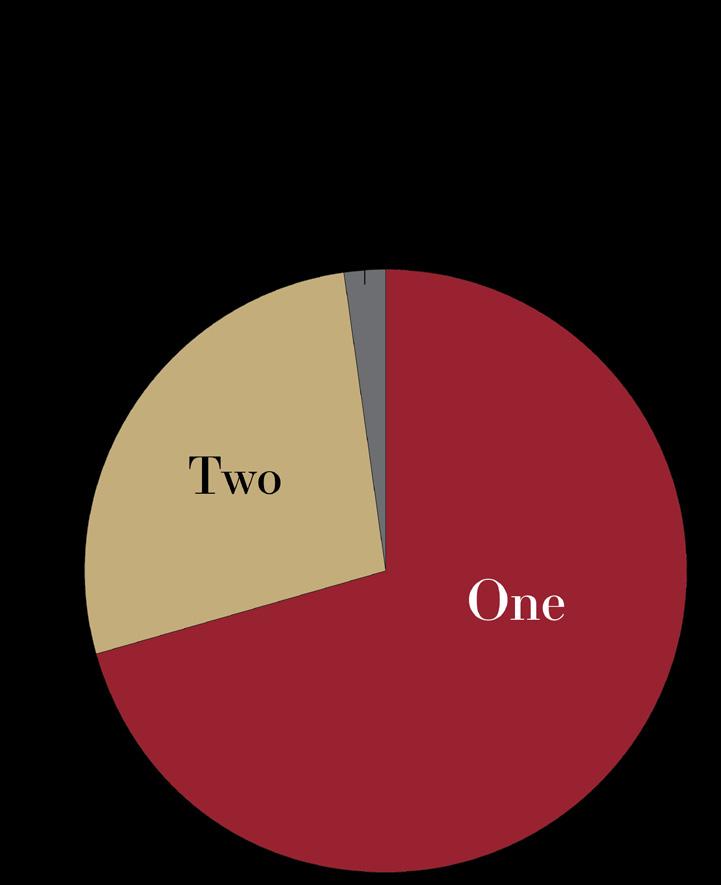

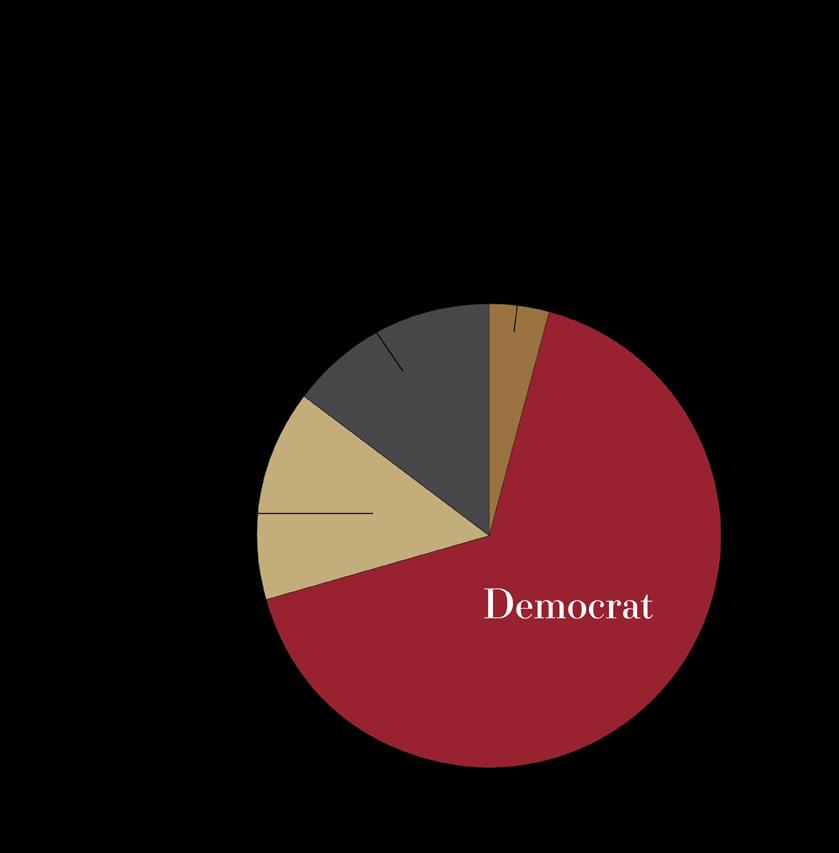

There have been some developments, however, specifically in regards to LGBTQ+ representation. A quarter of our editorial board identifies as bisexual or pansexual. In support of our own editors and members of the BC LGBTQ+ community at large,
The Heights will be prioritizing advertising space for organizations that assist and advocate for LGBTQ+ youth.
Lastly, we will also be publishing an inaugural diversity report, which tracks our progress or regression in the representation of many demographics through our editorial board. It’s a small step, but hopefully one that lays a transparent foundation for future progress and diversification.


If any community member would like to reach out to us to offer feedback or discuss our initiatives and shortfalls, please fill out this form on our website or send me an email. Through these initiatives, we hope that our actions over the coming year will demonstrate our commitment to making a positive and lasting impact on the BC community.
Sincerely, Megan Kelly Editor-in-Chief

first 100 days with little to show for it.
It’s no secret that the Democratic Party’s slim majorities in both the House and Senate are in a precarious position with the 2022 midterm elections on the horizon. Coupled with the historical trend of the president’s party virtually always losing ground in midterm elections, the situation is made even more grim for the Democrats by recent Republican-friendly redistricting and President Joe Biden’s tanking approval ratings. There are a variety of other factors that appear to doom the Democrats’ chances this November, including the persistence of the pandemic, inflation, and widely publicized roadblocks facing Biden’s key initiatives, such as the Build Back Better plan. According to a Gallup poll, the Democratic Party’s support dropped by seven percent in 2021 alone, the largest swing in over 30 years. It doesn’t have to be this way—but as long as the Democratic Party chooses to wax poetic about bipartisan compromise and carefully dodges any possibility of bold, progressive action, it will continue to be out of touch and will continue to lose.
During his 2020 campaign, Biden ran on the promise of unifying the country and returning to bygone eras of bipartisan compromise. The prospect of returning to political unity is a fool’s errand—chasing a political culture from over 30 years ago that will never return. From a logistical standpoint, this approach boxed Biden and the Democrats in from the start. Biden essentially wasted the first six months of his term on fruitless negotiations with Congress and walked out of his
The problem with a down-the-middle approach is that it leaves everyone dissatisfied. The conservative side of the party, like Senators Joe Manchin and Kyrsten Sinema, view many of the president’s initiatives as too progressive, while the progressive side of the party sees a graveyard of bold policy proposals that were abandoned in favor of the myth of bipartisanship. Ultimately, the hyper-fixation on the unattainable standard of unity exacerbates existing ideological fractures and has served to create even more congressional gridlock.



From a rhetorical standpoint, grand narratives about the ideals of bipartisan compromise appeal to the well-off liberals who have a more low-stakes relationship with public policy. They are the “margaritas and kickboxing” sect of the Democratic Party, like White House Press Secretary Jen Psaki, who can afford to view politics as a game they can watch from afar, rooting for their favorite side to win, but ultimately losing nothing in the process. For those who don’t have access to health care, the ability to work from home, or livable wages, lofty talk about unity rings hollow and uninspiring. The moderate approach to governing severely underestimates the gravity of the issues faced by marginalized people, and the stubborn insistence on unity by the Biden administration and congressional Democrats gives them the appearance of oblivion to the material conditions facing the majority of the country. It is unsurprising that a recent ABC News poll showed that 62 percent of registered voters view the Democratic Party as out of touch.

Among key demographic groups that make up the Democratic base, the disenchantment toward Biden’s approach to governing is visible in recent polling. The populations that Democratic politicians take for granted—namely young people and people of color—have had their needs and policy

priorities abandoned by the administration and have hardly any reason to be energized for the 2022 midterms. Biden’s promises of delivering student loan debt relief, a priority among young voters, have fallen by the wayside, and basic voting rights legislation has similarly failed.

The electoral strategy of the Democratic Party, or lack thereof, has recently taken the form of demanding that key demographics within the base, such as young voters and people of color, have a moral imperative to vote blue, but the Democratic establishment offers no forward-looking ideas or material progress to these voters in return. In 2020, Democratic politicians emphasized to voters that they needed to support Biden because it was the “most important election of our lifetime,” but this framing will only work once. Especially since it is no longer viable to frame the 2022 election as a reaction to former President Donald Trump, the Democratic Party needs to offer some incentive for people to turn out to vote for it, and vague talk of unity and normalcy are not going to cut it this time around.
In order to turn around the grim 2022 forecast, Democrats need to abandon the fantasy of unity and reorient toward achieving progress for the voters who delivered their victory in 2020. Unity is an amorphous ideal that Biden will never be able to reach, and he should abandon the futile efforts to control the level of bipartisan support he garners. Instead, the Biden administration should focus on what it can control: student loan debt forgiveness, drug policy reform, and strengthening anti-trust regulations, to name a few major policy strides Biden could achieve without needing Congress on board. The era of bipartisanship and unity has come and gone, so now it is time to focus on delivering results for working people.
As Boston College students wait in anticipation for that fateful day when all of BC Dining’s numerous locations will be fully staffed and ready to go, there is one consolation keeping things moving forward: the return of Late Night to the Rat. Juicy mozzarella sticks, tender chicken strips, and the frenchest of fries were all available once more for those midnight munchers looking for something not-so-fresh, but very fried, to satiate the cravings that unwanted packs of dorm room oatmeal can only dream of satisfying.
All is merry and bright when Gasson Hall is covered in white. The blizzard that blew through BC starting last Friday night and lasting all through the next day on Saturday left the campus blanketed in a soft, white, VSCO post–ready layer of snow. Students could be found crowding the hills around campus, blasting music, packing down snow to make makeshift ski jumps, throwing snowballs, and enjoying the beauty that is BC in a winter storm. There’s nothing like a bomb cyclone to bring BC students together for some core memory making.
best). The ultimate goal of this tedious tradition is to figure out what kind of snack I generally prefer and what this means for me as a person. And the results are in: I love food.
“Eat me? Alright, but goodness knows what this will do … ”
Unlike Alice, I do know what it will do and I do not, in fact, have to listen to some random, disembodied command (read: social media, older generations, or European folks, or a cookie) to eat anything if I do not want to. But more accurately, I also do not have to listen to some random, disembodied command telling me not to eat the things that I enjoy.
Like Alice in the mythical land of Wonderland, food is an avenue to finding out who I am. Alice found out that she does not particularly like being neither big nor small. Alice Size is the perfect size for Alice. But my identity does not boil down to the size of my body.
Over the past year I have spent month after month trying new snacks from different countries because of a relatively new invention of a monthly subscription box called Universal Yums. I have kept track of and recorded empirical data on my general opinions of the snacks I’ve tried and shared with friends from this subscription box.
There are a few main considerations I take into account when trying a new snack: the country of origin, the type of snack it is (chips, cookies, candy, etc.), and flavor profile (umami, bitter, sweet, etc.)—all of which determine a rating out of ten (zero being the worst tasting and 10 being the


I used to believe that if I were in Alice’s dainty shoes struggling to enter a rather passive-aggressive door and given the opportunity to eat a cookie inscribed with the words “Eat Me,” I’d jump at the chance. The data, however, shows that I tend to prefer salty and umami foods over sweet things, especially cookies. So maybe I wouldn’t necessarily “jump” for a cookie, but perhaps if I’m in the mood to try something new—and of questionable origin—then I’d give it a go. And that is the life of the intuitive eater.
More importantly, I believe that the action of trying new things with people that you love is a special chance to bond and create lasting memories. And for me, trying new foods is a surefire way to indulge in the spontaneity and curiosity that often gets trampled by school, work, stress, and responsibilities. Turns out, eating a strawberry licorice stick from Scandinavia and narrowly missing the trash as I immediately spit it out (because it was probably the most repulsive thing I’ve ever eaten) definitely made me forget about the B+ I got on a paper that one time two semesters ago. Although I gave that snack a zero rating, I found that I am someone who prefers to live in the moment, good or bad, rather than ruminate about the past.
This stunning revelation would not have otherwise been possible had I continued following the culture I grew up within. Thin was in and that was that. I placed so many restrictions on what I could do or eat that I did not even realize that I was missing half of my own identity. I restricted my eating and in turn I restricted my potential to try new things and enjoy the simple pleasures of life. And
for what? To appear happy when I wasn’t?
Since realizing that I deserve to be able to pursue the things that make me happy, my palate has grown and I’ve tried cooking various new things and subsequently sharing them and eagerly collecting the memories from these moments over and over. Food is a way to connect with others and an invitation to try new foods together is an invitation to share an experience with me that I will cherish.
With this, my body has changed. And instead of reflecting the rather antiquated beliefs of older folks of what my body is supposed to look like, I can cherish my body for what it has brought me through. Alice spent her entire time in Wonderland doing two things: eating things she probably shouldn’t have and explaining to various people who she isn’t rather than who she is. I may not have sat at the Mad Hatter’s Unbirthday Party, gotten lost in the Cheshire Cat’s forest, or ran away from the Queen of Hearts, but I have experienced 20 years’ worth of good and bad. My body reflects the strength I have from years of trusting it to tell me what to do and how to train. It reflects trial and error, doing new things, and a rather scientific approach to the simple task of eating. To think I need to throw that all away to satisfy those who do not live in my own body seems mad.
So, I know what will happen if I eat an ominous cookie. Chances are I won’t enjoy it as much as Black Pepper and Prosciutto Bread Bites, but I can appreciate the unique flavor it has. I can share it with my friends and live in the moment. And later, I can thank my body for giving me the tools to experience life to the fullest extent I can.
Veteran dining hall-goers know the power that a perfectly puffed, crunchy piece of popcorn chicken has to elevate an Eagle’s Nest bowl or salad to its status as a top tier meal. The power of the chicken is so great that even a simple bowl of popcorn chicken has the potential to be a meal on its own. Those who know, however, have recognized a dramatic shift in the quality of the chicken from its usually beautifully breaded, tenderized state to something completely unacceptable. Soggy and nasty, the situation with the chicken must be rectified in order to restore the BC Dining experience to its former glory.
On any given weekend in a city like Boston, events requiring ticketed admission abound—creating the perfect pathway for shady student scalpers to buy up tickets for popular events and then hike up the prices to the nth degree. Last Friday, for example, popular rapper Fetty Wap was slated to make an appearance at a highly frequented venue in Boston. Tickets were gone in a heartbeat, but only later did students realize that a certain incoming blizzard might put a halt on their plans to actually get into Boston. Suddenly, student resellers were re-listing their tickets at ridiculously marked up prices, making the event almost as unattainable as it was when tickets were sold out.
Remembered as a respected colleague, coach, and player, former Boston College football head coach Joe Yukica died on Jan. 22 at the age of 90. Yukica dedicated his life to football, serving as a Division I head coach for 21 seasons and later founding the New Hampshire chapter of the National Football Foundation (NFF) in 1987.
“More than anything, coach Yukica was a football guy,” Jay Fallon, president of the New Hampshire chapter of the NFF, said.

was named the New England Coach of the Year during his second season.
Two years later, Yukica, who was inducted into BC’s Varsity Club Hall of Fame in 2000, accepted the head coaching position at BC and immediately hired six assistants, including Bill Bowes, Pete Carmichael, John Anderson, and Jack Bicknell. At the time, BC had just completed two consecutive losing seasons, finishing 4–6 under then–head coach Jim Miller.
Yukica was critical to turning the program around and establishing BC as a football school, Gallup said.
“He set the foundation for the fu-
because he led by example, and he was a very professional type of person.”
Fallon, who said he attended several NFF meetings with Yukica, said that when Yukica walked into a room, you could tell he was a leader.
“He had a commanding presence—a true leadership presence,” Fallon said. “He was the acknowledged expert in the room based on his history. And not an overbearing presence, not an overwhelming presence, certainly not an egotistical presence, but a calming presence of confidence and competence in whatever it was he was doing.”
Dartmouth head football coach Buddy Teevens, who played under Yukica during his senior season when Yukica took over as the head coach at Dartmouth in 1978, spoke to his knowledge and mentorship as a coach.
“He was great to me,” Teevens said. “He let me call my own plays, which was unusual. He helped me understand the game in a way that I had not been exposed to.”
Yukica went on to lead the Big Green to an Ivy League Championship in his first season at Dartmouth in 1978, finishing the season 6–3 overall and 6–1 in conference play.
said he remembers Yukica’s demeanor.
“He set the course [with] his enthusiasm, his energy, his sense of humor.”
Teevens said. “He just made it light. He’d laugh on the sideline and throw out a one-liner on occasion—just kept us loose but focused.”
After Yukica’s coaching career ended, he never left the game of football. He founded the New Hampshire chapter of the NFF, which was later renamed the Joe Yukica New Hampshire Chapter.
The mission of the chapter, according to Fallon, is to promote amateur
for years to come.
“When he retired from coaching, he still had more to give,” Fallon said. “And what he did was … he gathered a coalition of like-minded football people to establish and charter a National Football Foundation [chapter] for the state of New Hampshire.”
Gallup said that Yukica went to a Darmouth-Princeton game this fall, just a few months before his death, with Greg Stewart, BC ’79, and Tom Lynch, BC ’77. At 90 years old, Yukica was as enamored with the game just as much as he was at the height of his career in

When Barry Gallup, BC’s senior
football
alumni relations, thinks about Yukica, he thinks about professionalism.
“He wore a shirt and tie to work,” Gallup said. “You don’t see that nowadays.”
Yukica began his college football career as a tight end at Penn State under former head coach Rip Engle. Upon his graduation, Yukica stayed on as a coach for Penn State’s freshman football team before working with a number of high school and college football programs, including as an assistant coach under Bob Blackman at Dartmouth for five seasons.
In 1966, Yukica became head coach at New Hampshire for two years and
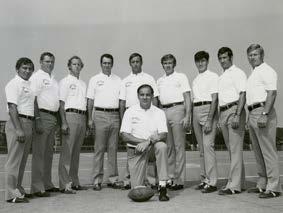
ture,” Gallup said. “BC was struggling financially in the ’70s. … We were a regional school … [which] doesn’t help, you know, your recruiting nationally and things like that. And coach set the foundation—he was there 10 years, he had nine winning seasons. I think he had, you know, a lot of guys go on [to] the National Football League, and a lot of guys have been very successful when their careers are over.”
While Yukica’s contributions on the field speak for themselves, Gallup said he admired Yukica for his character, referring to him as a teacher.
“He was definitely a teacher, but he wasn’t a screamer and hollerer,” Gallup said. “He had a presence about him. He was a professional. He was a mentor
“It was a wonderful transition to what could have been a real difficult situation,” Teevens said. “Guys believed, and he was just really good in terms of his attitude and his approach. … And we just kept winning, a band of no-names, because nobody was really the top star in the league. … Running through was one of the biggest highlights of all of our seniors’ careers.”
Teevens took over as Dartmouth’s head coach in 1990, and said that he takes inspiration from Yukica in his own coaching style.
“I’d call him, not often, for a little bit of advice,” he said. “He was always very thoughtful. … He’d think deeply about things. He wouldn’t answer right off the bat. He’d kind of mull it over, and then you could see his mind working, and then he’d come out with something that was just direct, on point, and very, very helpful.”
But more than anything, Teevens
Teevens said that Yukica’s impact will continue to impact young athletes
He
“Almost like he was coaching,” Gallup said. n
Despite a blizzard forcing a one-day postponement of Boston College men’s basketball’s game against Pittsburgh, the Eagles started to heat up Saturday.
The Eagles (9–11, 4–6 Atlantic Coast) finally tipped off against Pitt (8–13, 3–7) one day and 26 minutes late, and BC cruised to a 69–56 victory. The Eagles entered with a vengeance after their last matchup against the Panthers on Jan. 8, in which BC fell short by two points on a missed bucket at the buzzer.
Sunday’s game told a much different story. The Eagles looked to stop Pitt’s John Hugley following his 32-point showing in the teams’ last meeting.
“He was the main problem last game,” sophomore guard DeMarr Langford Jr. said of Hugley. “He was the main
guy we really had to shut down.”
BC’s defensive efforts held Hugley to nine points on Sunday.
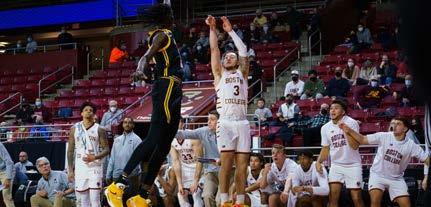
The Eagles’ defense also worked Pitt into multiple dry stretches by forcing the Panthers to take difficult shots and preventing offensive rebounds.
“Rebounding is a big part of how they score—that and shooting free throws,” head coach Earl Grant said in his postgame press conference. “We knew we needed to take away second-chance points, and we knew we needed to keep them off the free throw line, so I thought we did a good job of both.”
Pitt did not complete a field goal for the last 10 minutes of the first half, and the Eagles headed to the locker room on a 7–0 run and with a nine-point lead.
After regrouping at the half, Pitt came back to the court energized, opening up the half with back-to-back buckets. But BC quickly reclaimed its
dominance and took off with a 13-point run.
The Eagles held their lead for the remainder of the second half, even stretching it up to 22 points midway
through
“I
When Boston College women’s basketball headed to South Bend Sunday, having beaten Notre Dame in thrilling fashion just 10 days prior, the Irish were out for revenge.

And revenge is what they got.
With senior guard Makayla Dickens sidelined due to COVID-19 protocols, BC (14–7, 5–5 Atlantic Coast) split its season series with Notre Dame, as the Irish (16–4, 7–2) walked away with a 74–61 victory. With the win, Notre Dame remained undefeated at home.
“I do think it’s also hard to win when you’re just undermanned a little bit, like us not having [Dickens],” head coach Joanna Bernabei-McNamee said in her postgame press conference. “[She] could probably start for us as well. She plays starter minutes. That shortened up what we had, as far as scoring goes.”
Scoring wasn’t a problem for BC early, though. After Notre Dame quickly took an 8–2 lead, the Eagles responded and controlled most of the first quarter, scor-
ing 10 of the game’s next 12 points. The two teams entered the second quarter deadlocked at 14.
A Marnelle Garraud jumper to open the second quarter gave the Eagles a two-point lead, which turned out to be the last time Notre Dame trailed. Led by sharpshooting freshman Olivia Miles, Notre Dame exploded for a 15–2 run to take control of the game.
“What didn’t work for us was we just weren’t hitting our outside shots at all,” Bernabei-McNamee said. “So, you have the combination of one of their players taking over and our team just kind of going cold from the floor—it’s not a good look.”
With two minutes left to play in the half, BC had cut the deficit down to six points, but the ensuing plays encapsulated the Eagles’ issues all day.
After a block by Maria Gakdeng, BC looked to push the pace and score a quick transition basket. Instead, guard Kaylah Ivey’s pass attempt sailed out of bounds, putting the ball back in the Irish’s hands.
Down 35–27 at the end of the half— the exact same halftime tally of the teams’ last meeting—the game still was not out of reach for the Eagles, but BC continued
to struggle.
Miles and the Irish continued to torch the Eagles in the third quarter, while BC forced early shots and wasted numerous possessions. Notre Dame ended the third quarter up 19 points. With two minutes left, Bernabei-McNamee emptied her bench, closing the door on her team’s second straight defeat.
“For them, what went right is Olivia Miles played out of her mind and really took control of the game from the tip,” Bernabei-McNamee said. “We didn’t have a very good answer for her.”
The Eagles only connected on 18.2 percent of their 3-point
attempts and gave up 19 turnovers.
Sunday’s loss marked the first time all season that the Eagles lost two consecutive games, but Bernabei-McNamee said her squad is already looking to turn the page.
“I thought Notre Dame had a great game plan, and they played really well—switching up from a man to a zone and continuing to keep us on our toes all game,” Bernabei-McNamee said. “For us, we just got to learn, we got to grow from these losses, and we got to get ready to play at home on Thursday.” n
Forecheck, backcheck, paycheck.
As the saying goes, pressure and physicality pay dividends, and in Boston College men’s hockey’s matchup with Maine Friday night, that was certainly the case.

Despite entering the game as the underdog, Maine (4–14–4, 2–10–2 Hockey East) played a more physical game to defeat BC (10–11–4, 5–8–3) by a final score of 4–1. BC’s loss extended its win drought to seven games—the Eagles haven’t won since their victory over Dartmouth
on Dec. 31.
Maine’s first goal exemplified its grit and hustle. Jakub Sirota bombed a slap shot at BC goaltender Eric Dop, and a cluster of Black Bears in front of the net screened Dop, handing Maine a lead that it would never relinquish.
Grit continued to be the theme for Maine the rest of the night. The Black Bears refused to give up anything easy to the Eagles and protected the blue line, as BC struggled to get clean zone entries and set up its usually fast-paced offense.
Maine paired its stingy blue-line defense with backchecking and forechecking. BC’s defenders frequently use cross-ice passes in the defensive
zone to get a break down the ice. Maine’s forechecking forwards exposed BC’s tendency, however, when Adam Dawe picked Mike Posma’s pocket with a stick play as he weighed his options on the breakout. Dawe then walked in on net and gave the Black Bears their second goal.
Dawe’s tally was enough for Maine’s victory, as BC’s only goal of the night came when Marc McLaughlin tipped in a rebound in the second period. McLaughlin leads BC and Hockey East in overall goals scored this season with 18.
The Black Bears went on to score two more in the third, both by Grant Hebert to make the score 4–1. Five of the Eagles’ 11 losses this year have
come by three or more goals.
The Eagles were without head coach Jerry York, who was absent due to COVID-19 protocols, on Friday. York is expected to return before BC’s matchup with Harvard on Feb. 1.
Friday night marked the last game McLaughlin and Drew Helleson will play for the Eagles before they will head to the 2022 Winter Olympics to represent the U.S. Teammate Jack McBain will represent Canada at the Olympics.
The Olympics leave the Eagles without McLaughlin, Helleson, and McBain in their next two matchups against Harvard and UMass Lowell, as well as the upcoming Beanpot. n
By MeGan Gentile Sports EditorFor just over 44 minutes of Boston College women’s hockey’s matchup against Connecticut on Friday, the score stood at 0–0. But it took just over two and a half minutes for each team to get on the board and tie things up once again 1–1.

After an uneventful opening two frames, the Eagles went on to score two more third-period goals, and BC (14–11, 12–8 Hockey East) prevailed over the Huskies (19–6–2, 13–5–2) with a 3–1 win.
Despite the final score, UConn finished with the upper hand in almost every line of the stat sheet Friday night. The Huskies shot more than double the amount BC did, finishing with 45 shots compared to BC’s 22 and won 36 faceoffs compared to BC’s 20. UConn also spent less time in the penalty box, totalling eight minutes on four penalties, while the Eagles
spent 12 minutes on six penalties.
But ultimately, BC outscored UConn, walking away with its first win against the Huskies in three games this season.
After going scoreless through the first two frames, UConn’s Viki Harkness slotted a power-play goal past BC goaltender Abigail Levy in the fourth minute of the third period to break the scoring and put the Huskies ahead 1–0.
Just two and a half minutes later, Caroline Goffredo scored the tying goal with 12:45 left to play. After BC capitalized off puck retrieval in its win against Providence on Tuesday, Goffredo scored the equalizer off a loose puck.
Just a minute and a half later, the Eagles netted another one. Natalie Tulchinsky tipped in a wrist shot from Olivia Finnochiaro to score the go-ahead goal. The game-winner marked Tulchinsky’s first goal of the season.
UConn outshot the Eagles through the rest of play but could not convert on any of its attempts. Levy made a total of 44 saves on Friday in
her fifth 40-plus save game of the season.
After the referees sent Goffredo to the penalty box for body checking in the 12th minute, Hannah Bilka joined her in the 14th minute for the same
call, giving UConn a 5-on-3 advantage.
In the second 5-on-3 power play of the game—BC failed to convert on a two-man advantage midway through the second frame—the Huskies didn’t
put a single shot on net.
BC’s Abby Newhook scored an empty netter from behind the center line with 53 seconds to play, scoring BC’s third goal of the third period and sealing the deal for the Eagles. n